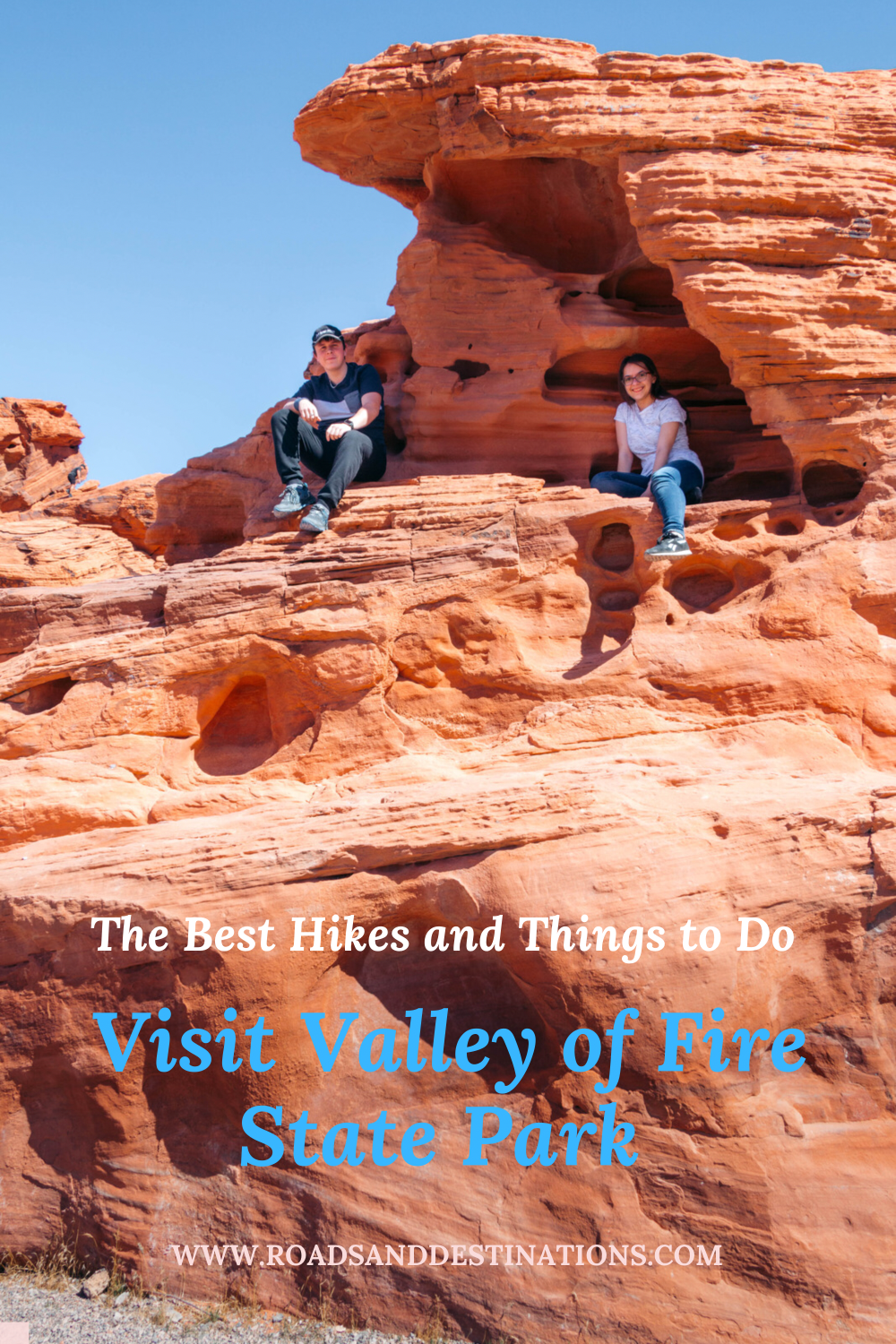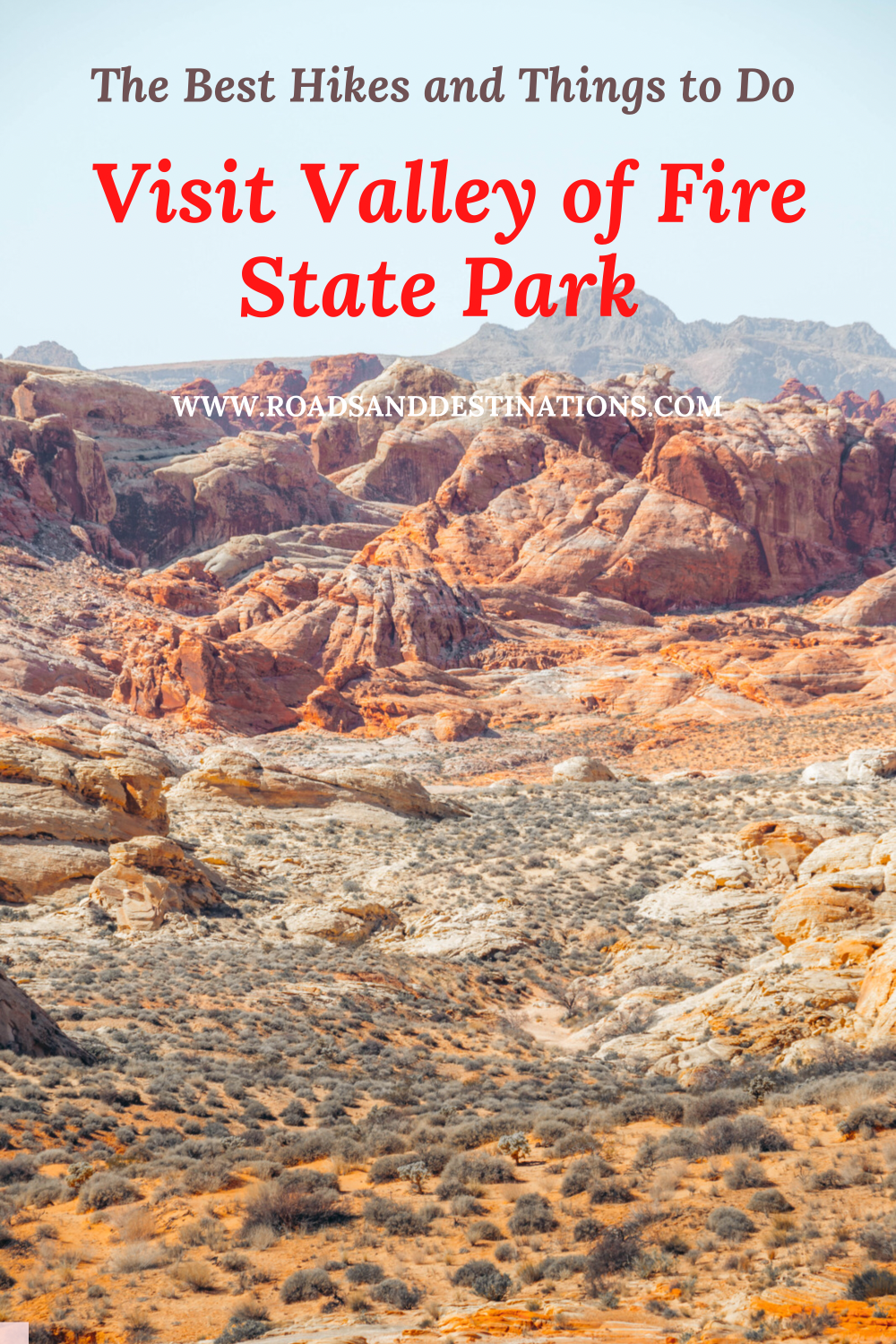I had to convince Roshan to plan for a day in Valley of Fire State Park, Nevada, during our road trip across the American Southwest. We didn’t know what to expect at first, but what we saw didn’t disappoint.
Last updated: June 19, 2025
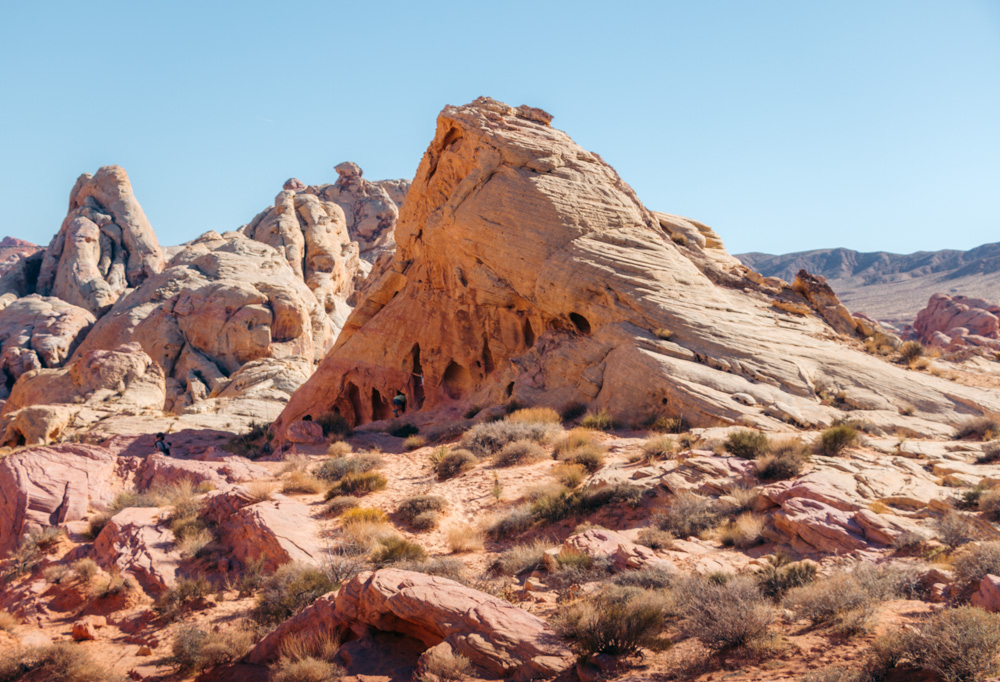
Visiting Valley of Fire State Park
If you’ve never thought about adding a visit to Valley of Fire State Park to your Nevada road trip, do it now. The area has everything to keep you on your feet and constantly wow you with its impeccable landscape. From natural sandstone arches to slot canyons and multicolor rock formations, the park showcases the best of Nevada.
Are you more into history than nature? Then you should definitely spend a day in Valley of Fire State Park. Once a seasonal home to some Native American tribes, the place still keeps their legacy alive. Some areas of the park are loaded with ancient petroglyphs that date back more than 2,000 years.
Apart from humans, the forces of nature have made their mark on Valley of Fire State Park. The work of the water and wind is not complete yet. Unnoticeably to the untrained eye, nature ceaselessly reshapes the surface of the park the moment you read this.
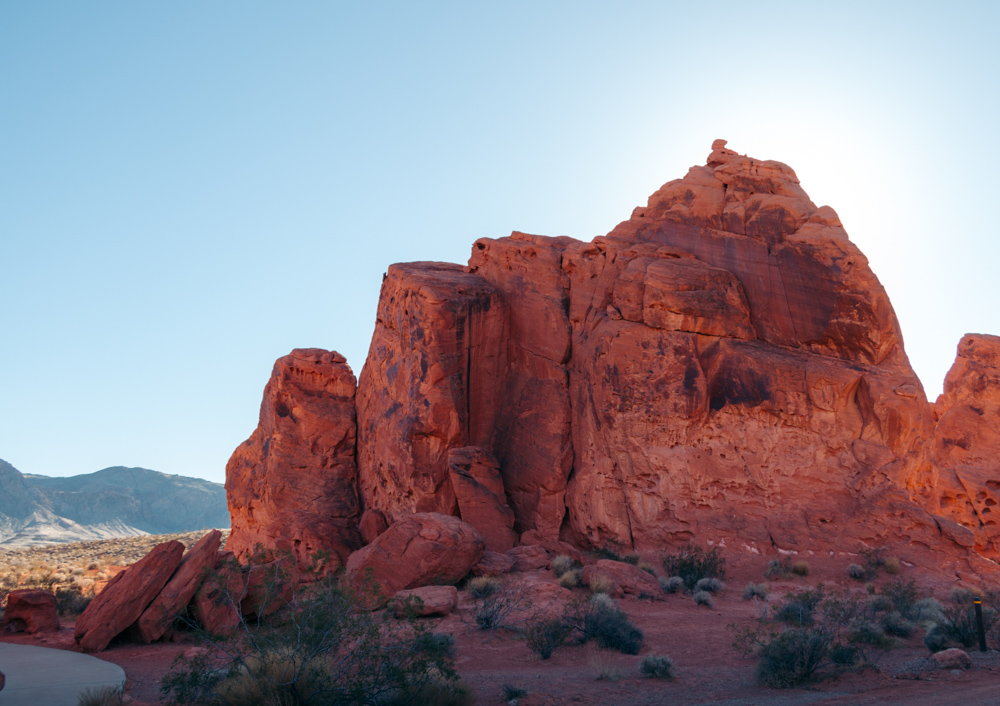
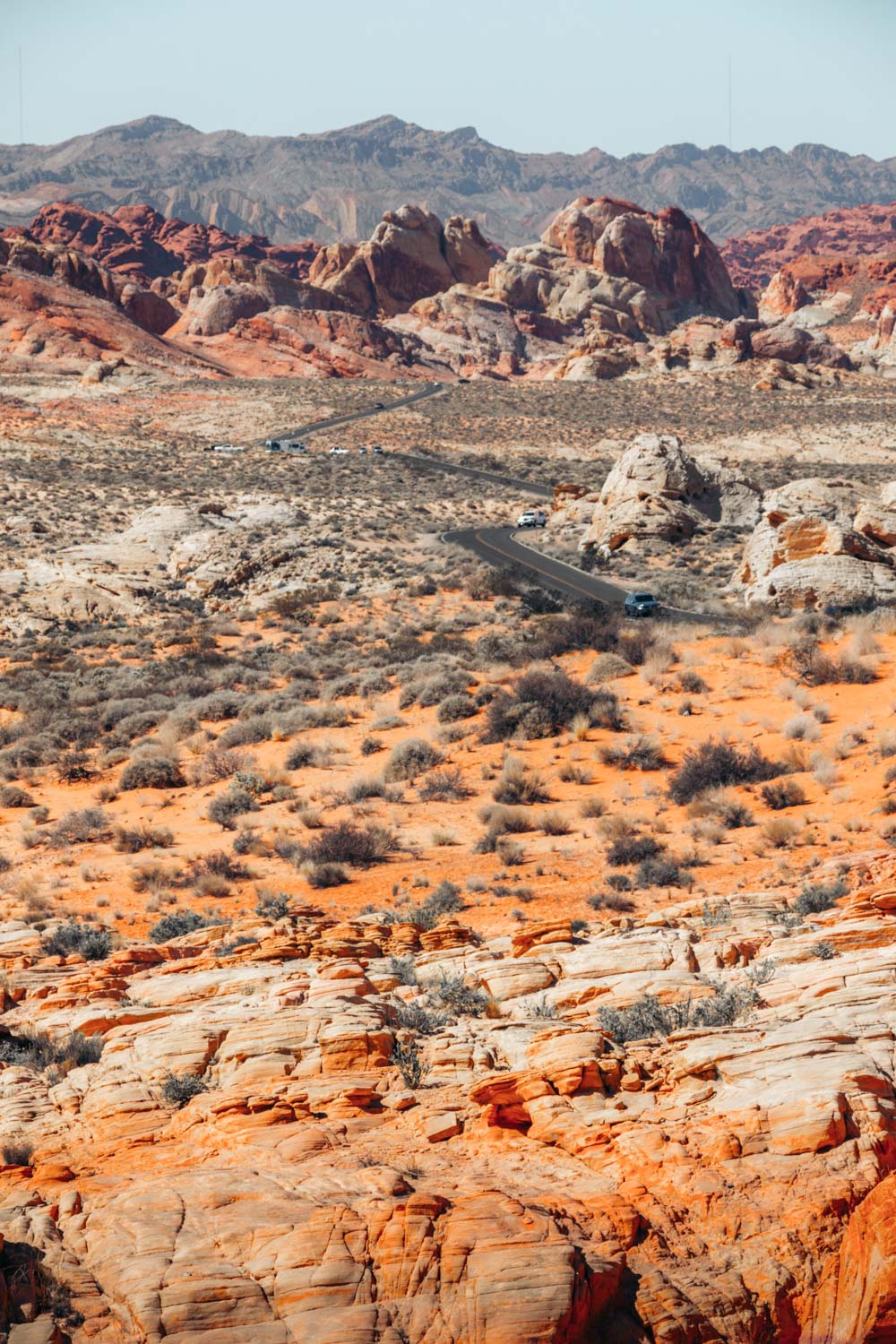
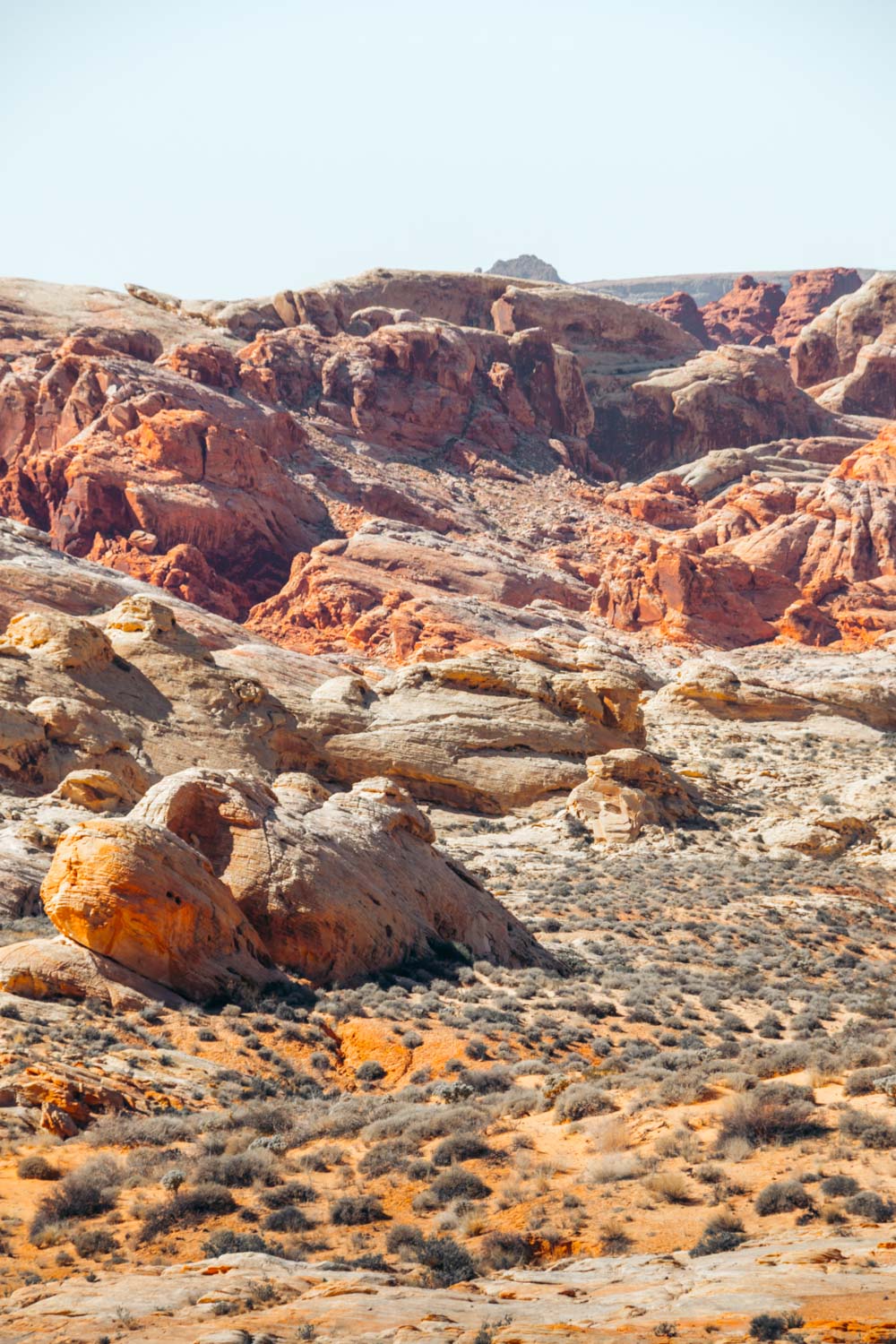
Why Should You Spend a Day in Valley of Fire State Park?
A completely different landscape and natural attractions will be on display for people who visit Valley of Fire State Park hundreds of years from now. More spectacular sandstone formations or slot canyons may be adorning the region at that time. You can’t tell for sure how the area will look in the future. But you certainly should visit and spend at least one day in Valley of Fire State Park now to admire its diversity before it changes.
To make your first visit to the Valley of Fire more enjoyable, we have prepared the complete guide with some of the helpful tips and tricks. Furthermore, you will find a map of the best places to explore in the area at the end of this article. Finally, this guide to visiting Valley of Fire State Park will introduce you to the best hikes and the most photographic places in the region. Let’s start this outdoor adventure.
Visiting Valley of Fire State Park
What sets Valley of Fire State Park apart from other alluring places in Nevada and the American Southwest? Some say that the area looks like it has been put on fire during sunset. Others insist that the park has the most astounding natural landmarks in the state. Yet still many visit Valley of Fire State Park to drive along the most beautiful road in Southern Nevada.
Indeed, there are many reasons to visit Valley of Fire State Park. Famous for its 40,000 acres of Aztec sandstone formations, the place has festooned itself with bountiful natural shades on top of its signature reds. From vibrant yellows to beiges, oranges, and pinks, vibrant colors adorn the Valley of Fire, making it its own skillful painter.
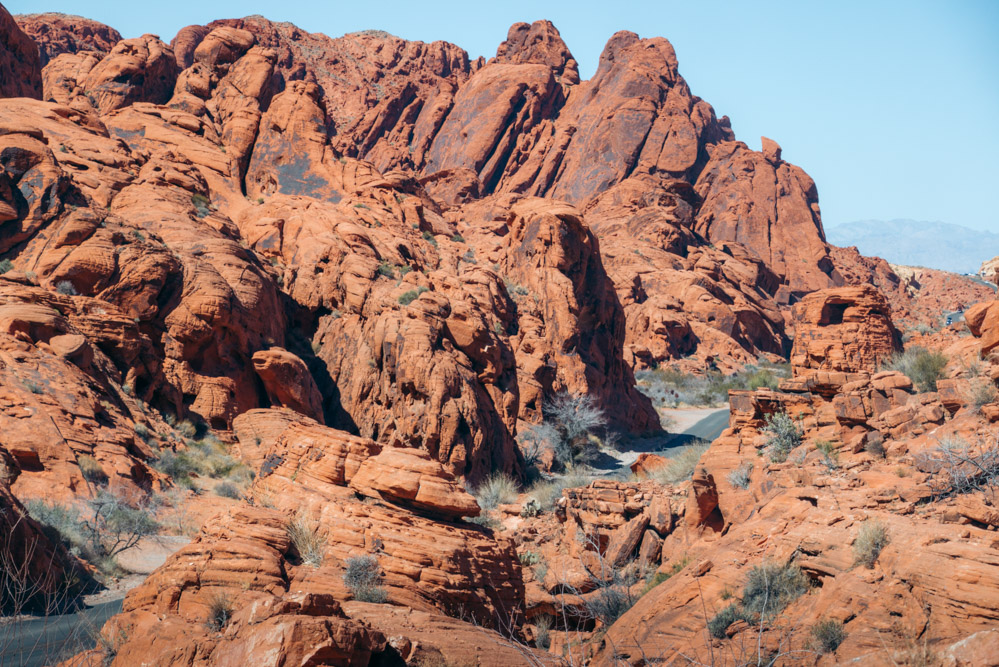
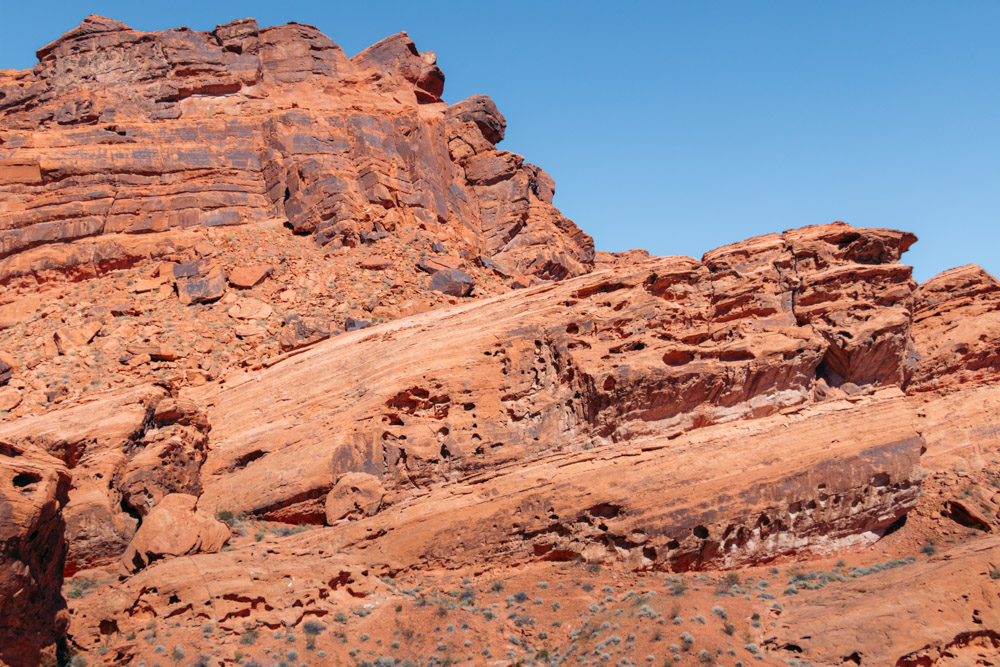
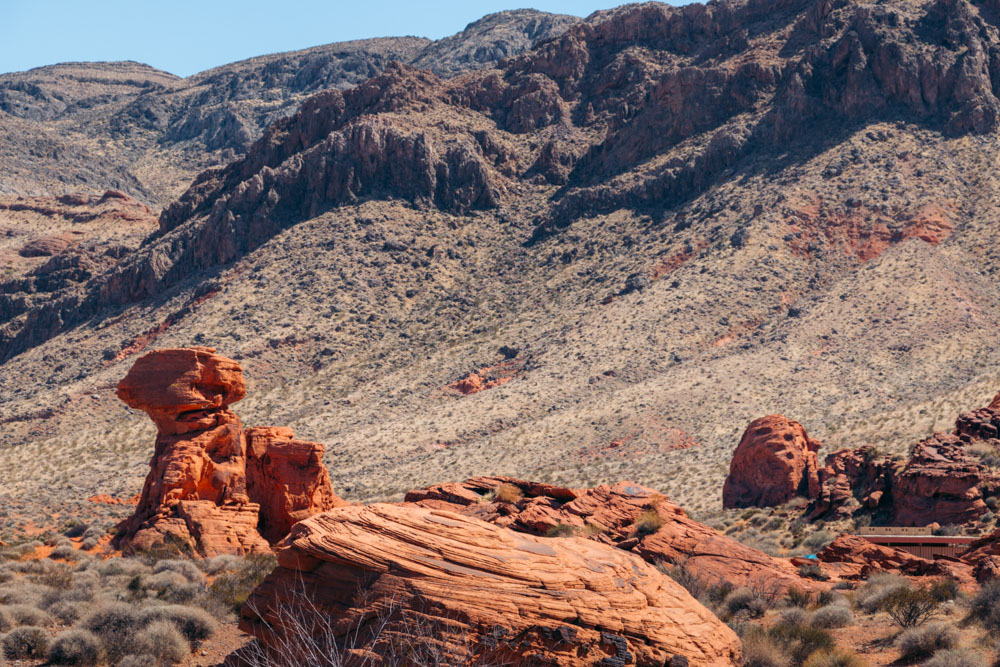
Valley of Fire State Park: History
Yet the brilliant colors are not the main inspiration for your trip to Valley of Fire State Park. The area that was officially opened as Nevada’s first state park in 1935 bewilders with its history and geology.
The place looked entirely different millions of years ago. At one point, Valley of Fire State Park was submerged under the sea. Over time, the water slowly dried up, transforming the area into a place of mud floods and slow-moving streams.
When the moisture completely disappeared, a vast sand dune desert claimed its rights to the area. The transformation had yet to continue. Being constantly molded by tireless wind and water, the sand dunes cemented together into the striking sandstone formations the Valley of Fire is known for.
Interesting Fact: The bright coloration of the rock outcrops is the result of icon oxide, silica, and manganese present in the area. So much for the mystery of the place after all.
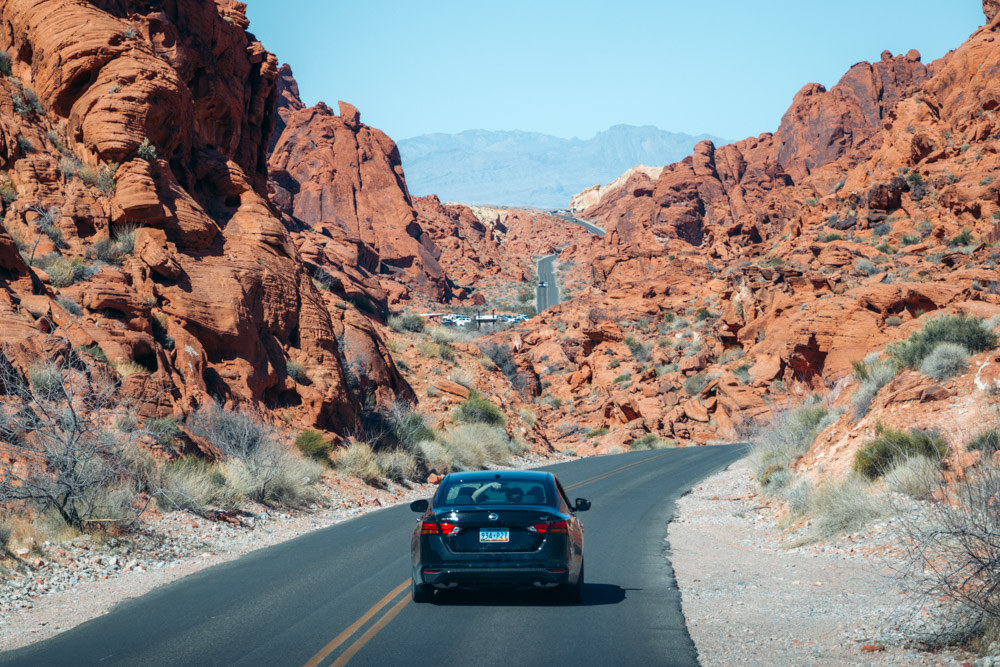
Visit Valley of Fire: Location and Directions
Located less than an hour away from Las Vegas, Valley of Fire State Park welcomes hundreds of thousands of visitors a year. The Valley of Fire sits in the Mojave Desert, about 47 miles from the City of Lights. Overton, located nearly 11 miles away, is the nearest place to the East Entrance.
Visiting the Valley of Fire by car is by far the most convenient way. The park has two entrances: West and East. The main landmarks of the area are nestled a short drive from either of these entrances. The majority of international travelers fly into Las Vegas and visit the Valley of Fire on a day trip.
Visit Valley of Fire from Las Vegas
Take I-15 N and drive for approximately 33 miles. Take exit 75 (follow signs for Valley of Fire State Park and Lake Mead National Recreation Area). Merge onto Valley of Fire Highway and continue on for about 12 miles. It takes approximately 50 minutes to reach the park.
Visit Valley of Fire from Overton
Take NV-169 S and follow it for approximately 9 miles. Turn right onto Valley of Fire Highway and continue on for about 1.3 miles. The drive is approximately 15 minutes.
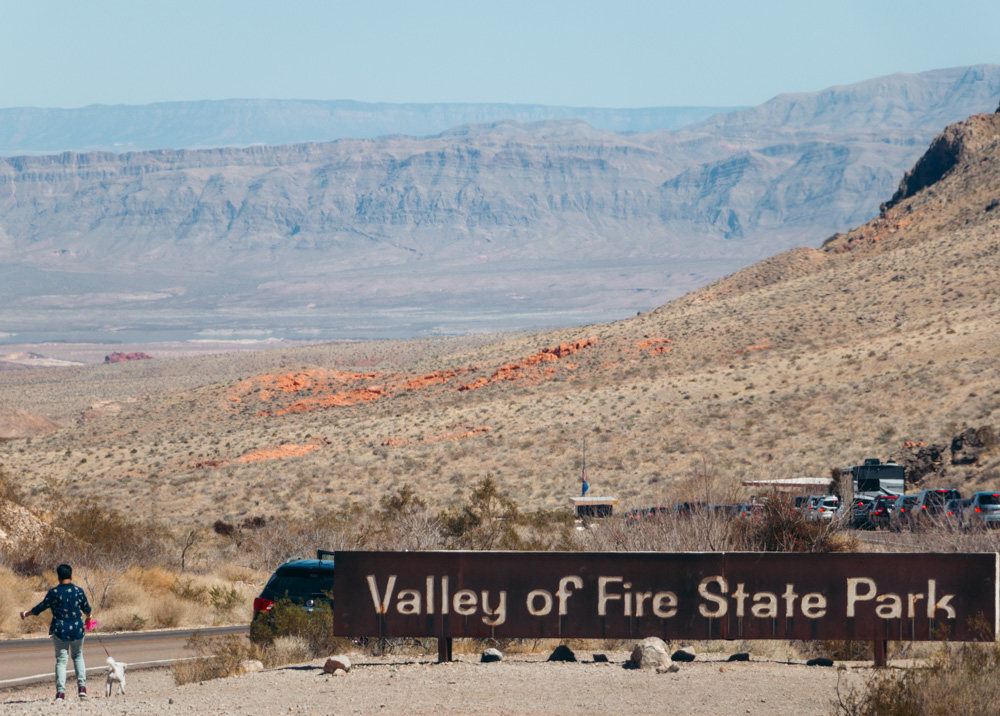
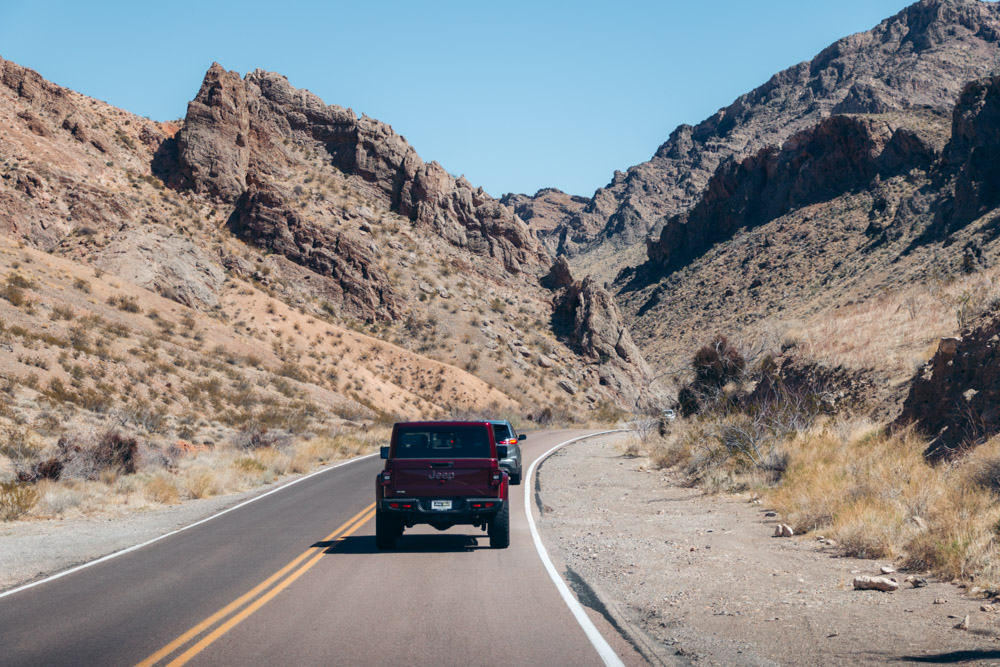
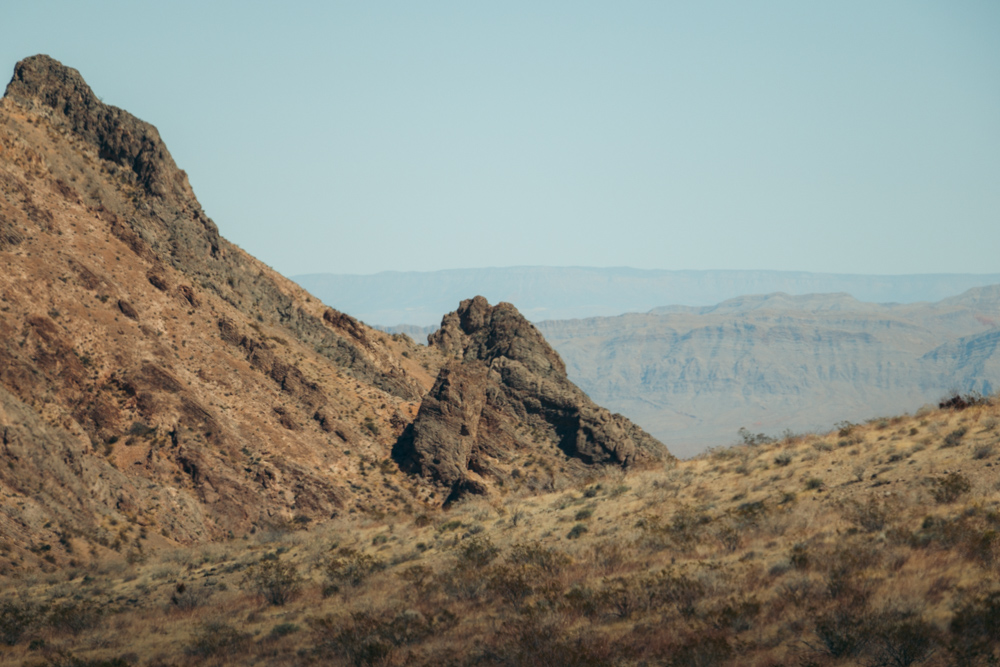
The Best Time to Spend a Day in Valley of Fire State Park
The park keeps its doors open all year round, from sunrise to sunset. Those who wish to visit Valley of Fire State Park and stay overnight must get a camping permit.
Visit the Valley of Fire during the Late Spring-Early Summer (Peak) Season
Located in the Mojave Desert, Valley of Fire State Park is not an ideal place to visit during the hot summer days. Normally, daytime temperatures reach up to 120 degrees Fahrenheit. Frankly, it’s too hot even for desert inhabitants that are mostly active in the wee hours or at night.
Day visitors are recommended to plan their visits to Valley of Fire State Park either in the early morning or late afternoon.
Visit the Valley of Fire during the Slow Season
Nevada’s monsoon season, which happens from July through August, as well as winter months also present some challenges. If you don’t mind getting a little bit wet in the desert, plan your day visit to the Valley of Fire at this time.
Those who long to explore the park’s slot canyons should do it before noon. Summer thunderstorms are frequent in the afternoon. Hiking in the slot canyons during the rainy season can be dangerous due to flash floods.
Visit the Valley of Fire during the Shoulder Seasons
Spring and fall are the most enjoyable times to spend a day in Valley of Fire State Park. The temperatures are never too hot or too cold. Furthermore, practically no precipitation disturbs your outdoor excursions.
TIP: In the spring, vibrant wildflowers reward you with an additional pop of color. The White Domes Trail usually steals the show with yellow hues that adorn the desert floor.
If it’s not enough, fewer crowds visit Valley of Fire State Park during the shoulder seasons, making it a primary destination for photographers that don’t want to be disturbed by other hikers.
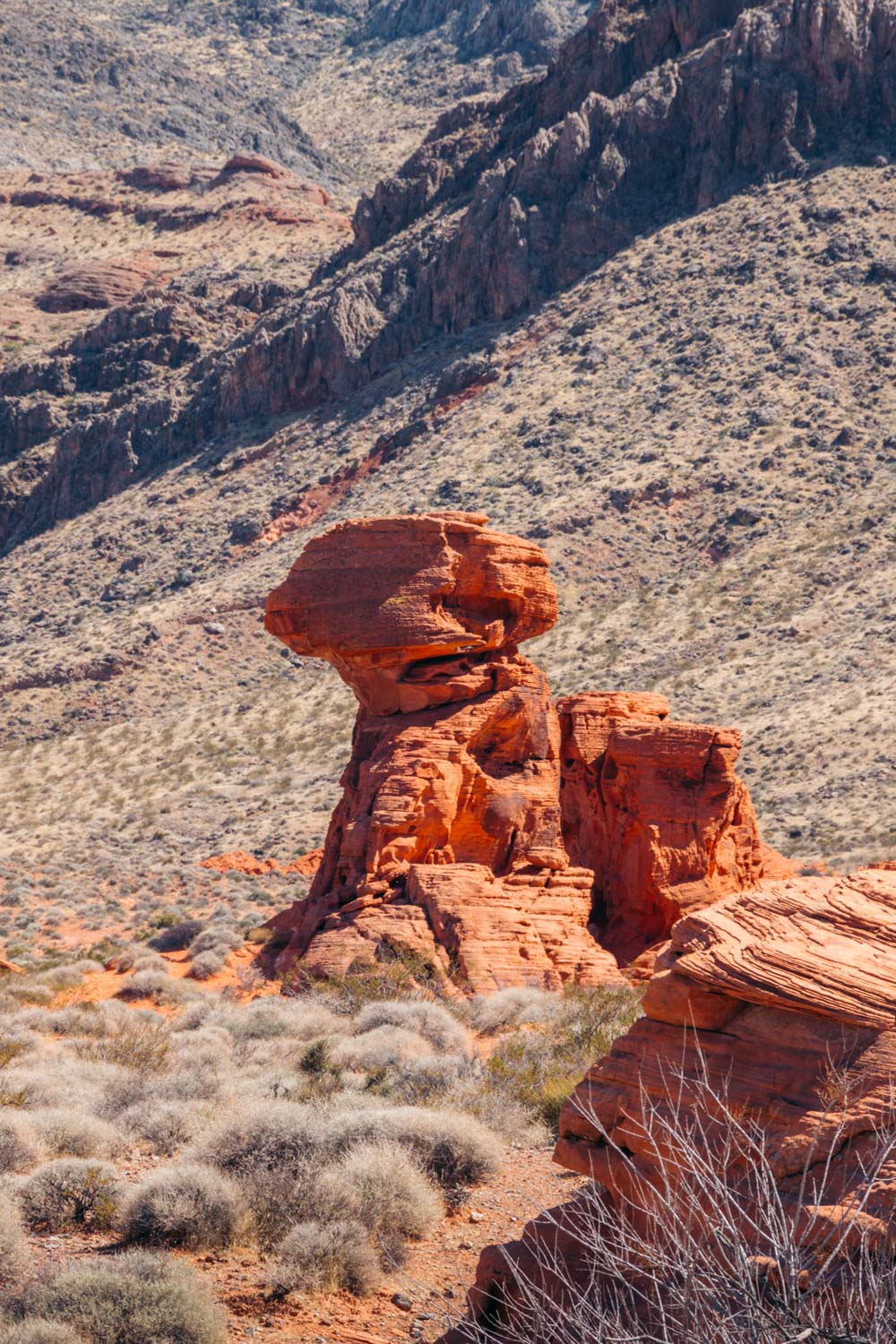
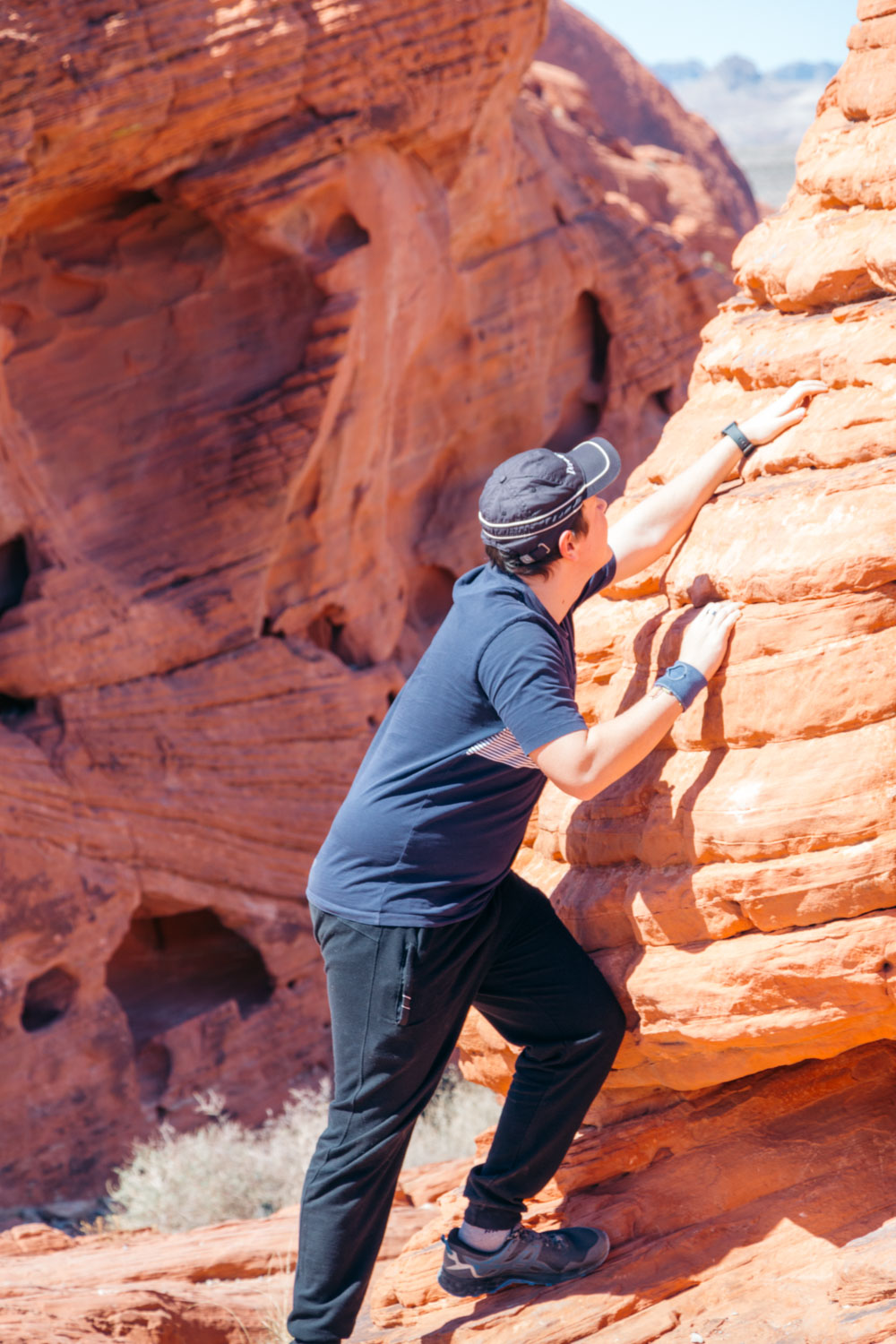
THE BEST THINGS TO DO IN VALLEY OF FIRE STATE PARK
If you’ve never been to Valley of Fire State Park, plan that day trip as soon as possible. The area is capable of impressing even the most skeptical city lovers, leave alone the enthusiastic outdoor adventurers. From flawless desert vistas, to rock climbing, cycling on the roadways throughout the park, and hiking to the unique sandstone formations, a visit to the Valley of Fire packs a lot in just one short day.
Without further ado, here are the best things to do and places to see in the park. Have I mentioned that many of these attractions are nestled near the main road? Several, however, require some hiking.
1. Beehives
An easily recognizable group of the red sandstone formations grabs your attention almost as soon as you enter the park from the West Entrance. As you get closer, a roadside sign confirms that you’ve reached the Beehives.
A small parking lot right in front of the area normally has plenty of spaces, considering that you plan your day trip during the shoulder or slow seasons. Pull over and feel free to climb the rocks and explore small caves at the bottom. A short trail winds through the Beehives and offers beautiful views of the Muddy Mountains in the distance.
It’s not an accident that the place was named after dome-shaped structures in which bees are kept. Indeed, the large sandstone formations nestled close to each other look like giant beehives.
Interesting Fact: Once you look closer at the rocks, you can see prominent grooved lines striping the formations. These lines attest to multiple layers of silt that was deposed at different times. A trained eye can even recognize the angles at which the wind was moving at the time the natural materials were deposited.
Campgrounds: With 3 group campgrounds, restrooms, and a picnic shelter, the Beehives area suits both day and overnight visitors.
2. Scenic Loop Road
While campers can stay at the Beehives area, day visitors should get back on the road and explore other natural attractions. The 2-mile Scenic Loop Road comes next.
Featuring some of the most interesting rock formations, such as Arch Rock and Piano Rock, the road is regarded as one of the most panoramic drives in southern Nevada.
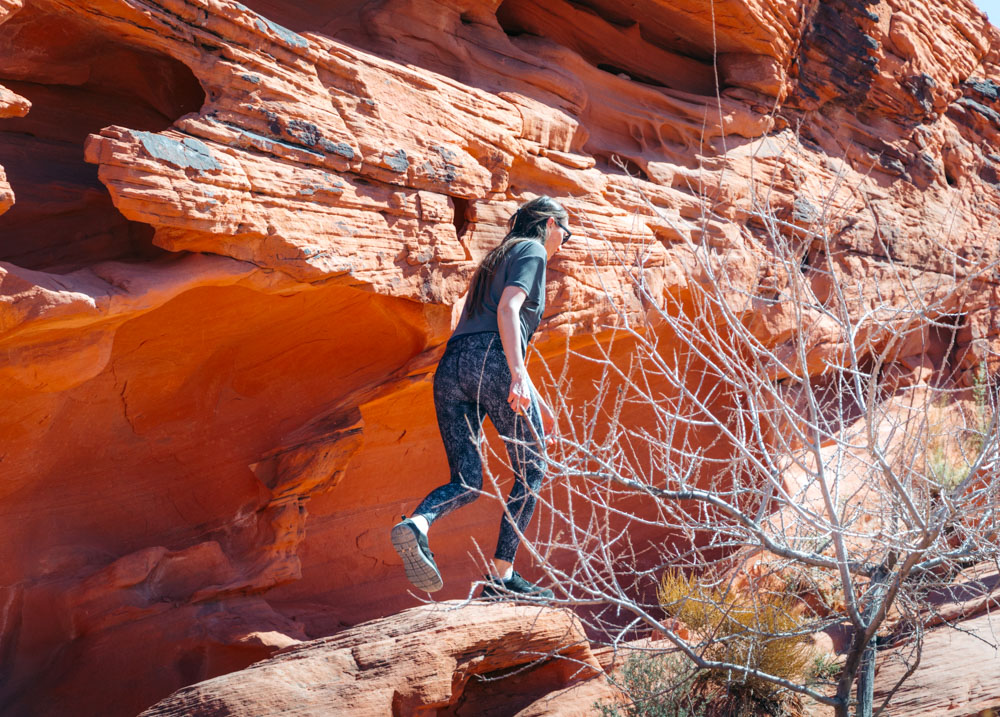
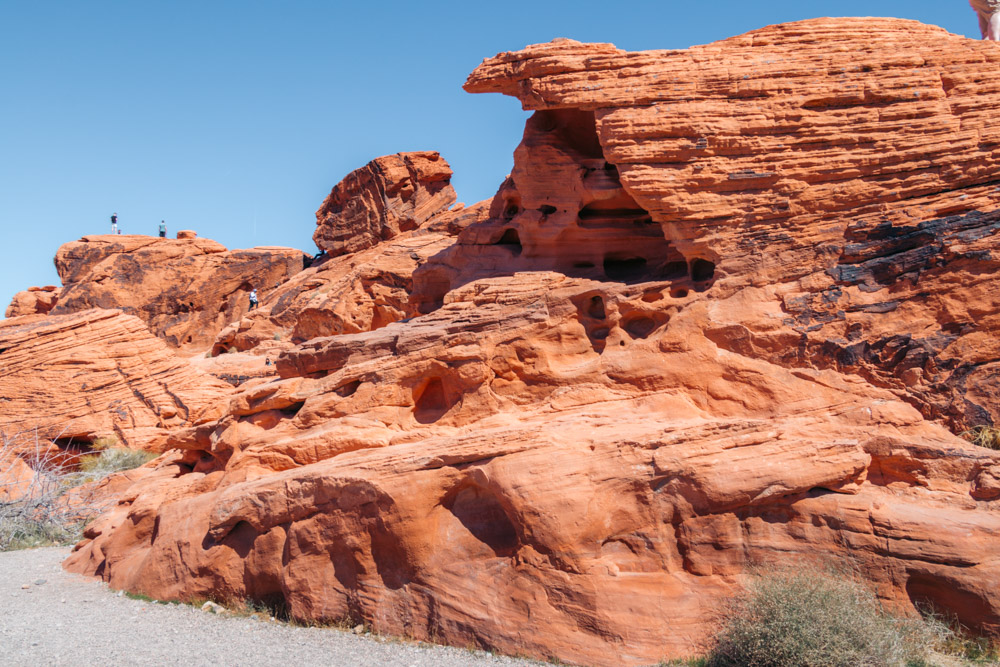
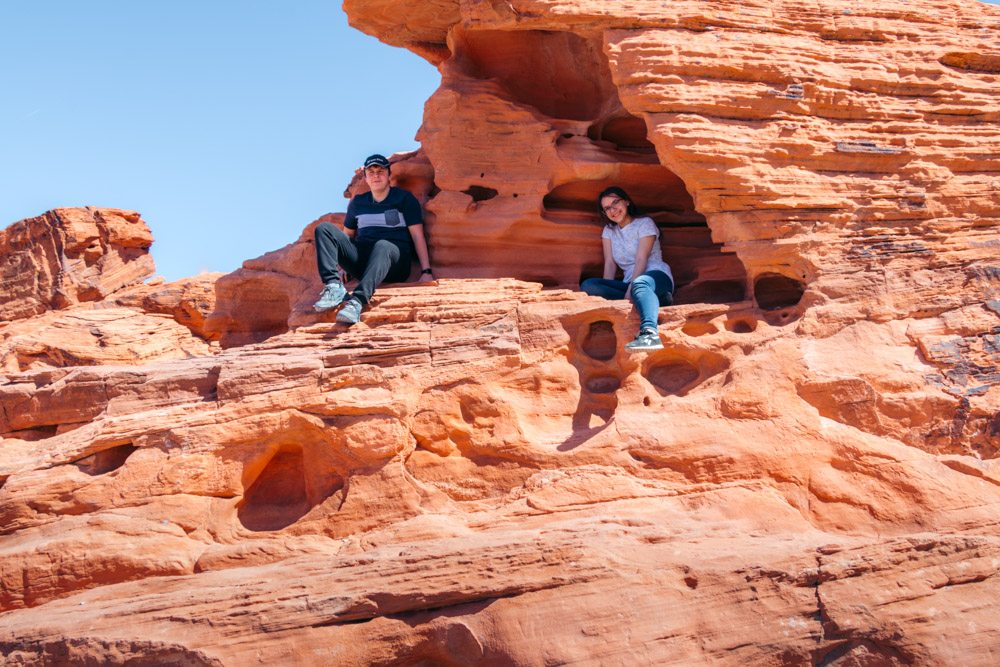
3. Atlatl Rock
One of the first places you want to visit near the West Entrance of the Valley of Fire is Atlatl Rock. Dotted with the spectacular petroglyphs that date back nearly 3,000 years, this place is of most interest to history buffs.
Even the name of the rock has a direct connection to ancient Indian tribes that lived here centuries ago. “Atlatl” was a device used to propel a spear. You can find images of this primitive weapon along with drawings of animals and things that have no meaning in today’s society carved on the massive walls of the rock.
TIP: For an overnight stay, head to the adjacent Atlatl Campground. With 44 campsites, it’s one of the most popular camping places in Valley of Fire State Park. Keep in mind, though, half of the campsites are primitive and half are equipped with water and power hookups. So, if you travel by RV, claim one of these spots early, before they are all occupied.
4. Arch Rock
Continue on along the Scenic Loop Drive to visit another popular landmark of Valley of Fire State Park. Alluring with its spectacular shape, Arch Rock is especially popular among photographers.
While the latter capture the natural beauty of the formation at different lights, history and geology enthusiasts marvel at the rock’s story. Presumably, the arch was formed by strong winds and rain that slowly washed away the materials holding its sand grains together. Over time, the weakened part of the rock fell off, allowing the natural arch to form.
TIP: They predict that the iconic landmark will eventually collapse under its own weight. So, climbing on Arch Rock is not allowed. Let’s preserve this remarkable natural wonder for many other visitors of the Valley of Fire to enjoy.
Campgrounds: The Arch Rock Campground sits near Arch Rock. Its 29 rather primitive campsites operate seasonally, on a first-come, first-served basis.
5. Fire Cave/Winstone Arch
Fire Cave or Winstone Arch is not an easy place to explore during a day trip to Valley of Fire State Park. Nestled near the Scenic Loop Road, the rock formation is so tiny that many day-trippers often miss it. Those who intend to go off-the-beaten path to find this hidden gem should drive almost to the end of the scenic road. Park and hike for a couple of minutes. Don’t walk too far or you risk missing the cave-arch.
TIP: The last stretch of the Scenic Loop Road is unpaved. Nevertheless, all cars can safely traverse along this section.
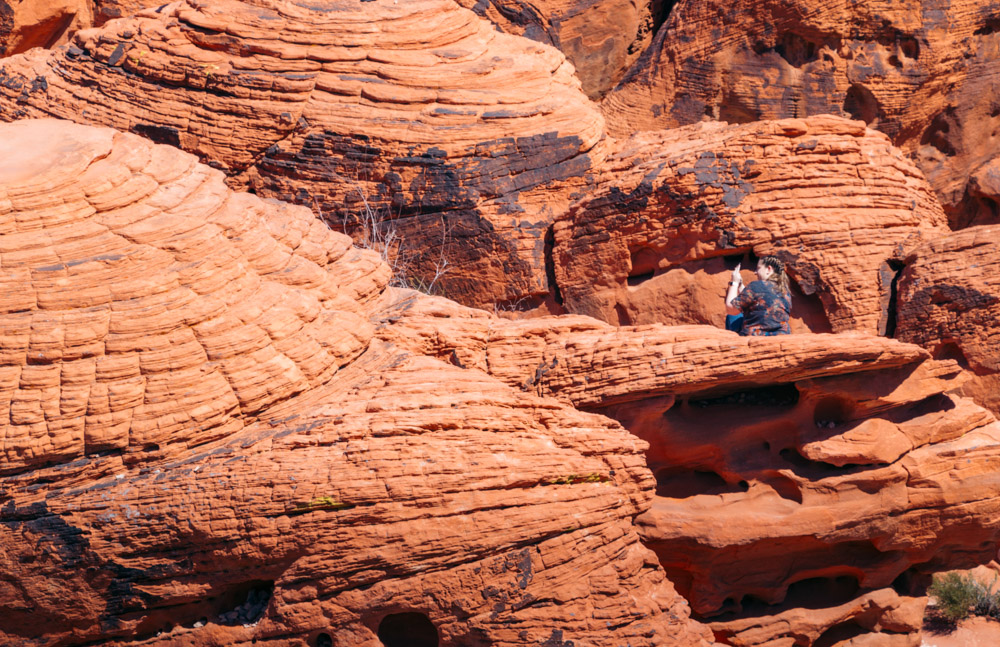
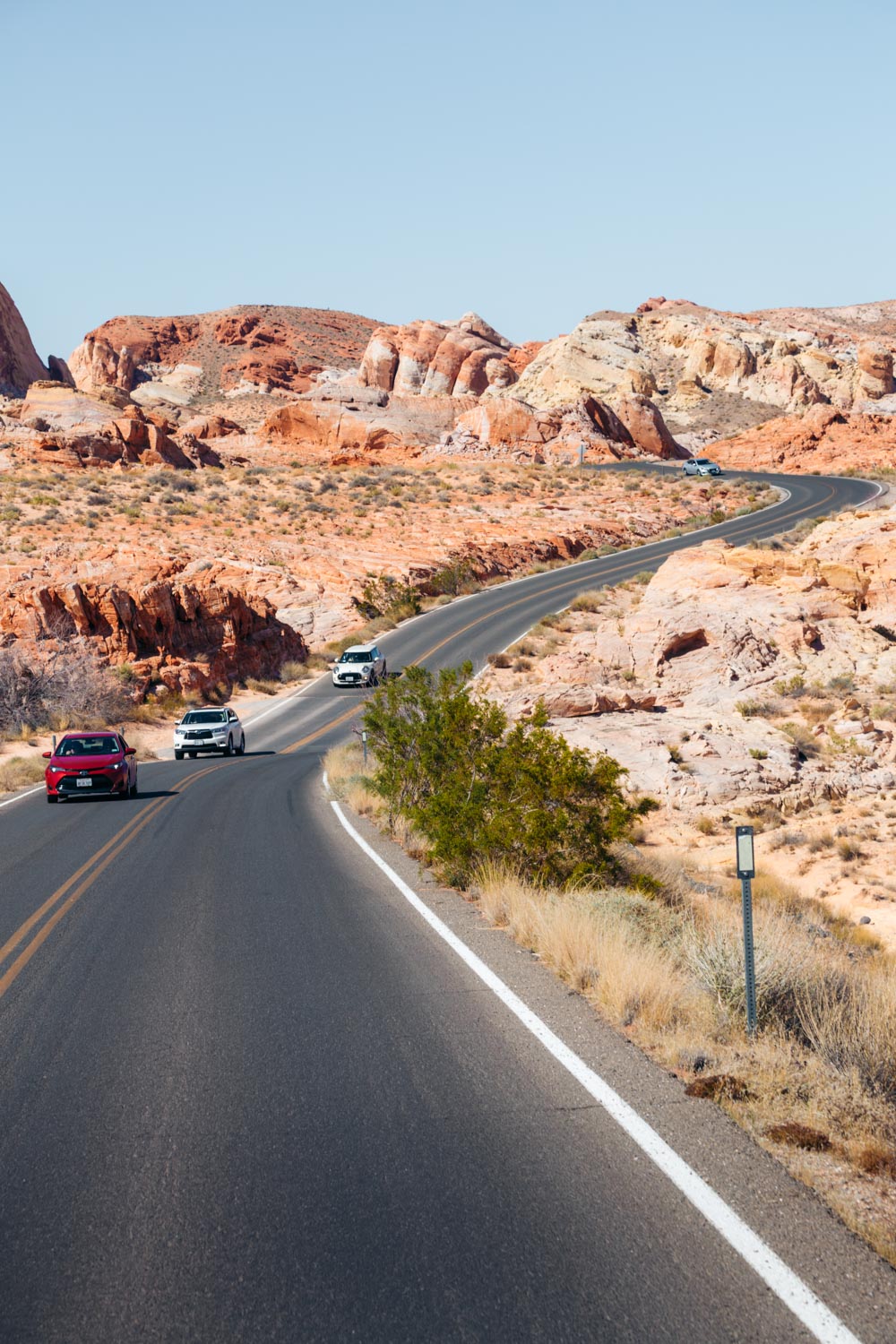
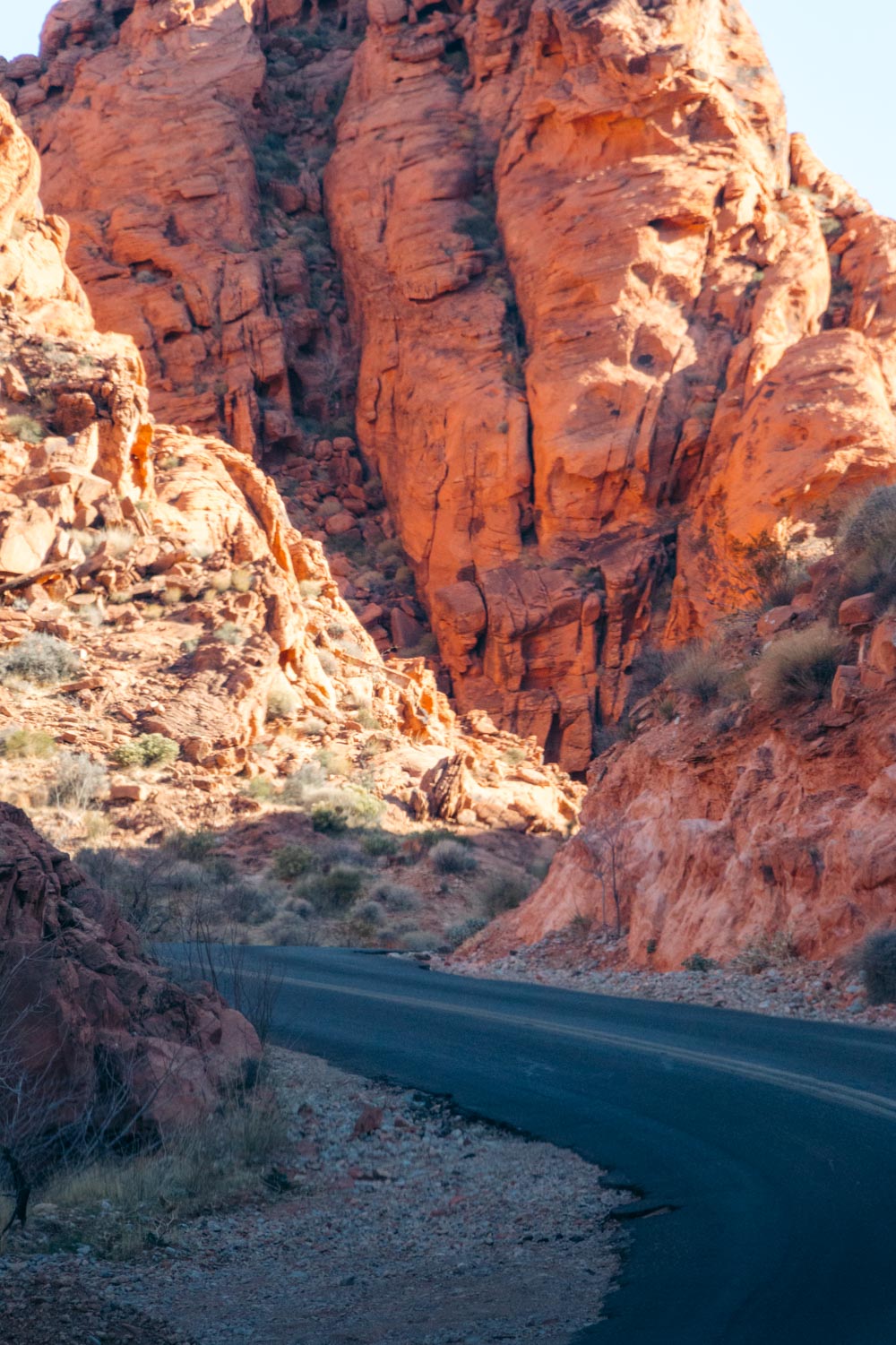
6. Petrified Logs
Whether you start your day in Valley of Fire State Park at the West or East, two Petrified Logs’ sites welcome you not far from each entrance. What is so interesting about these dead trees? Normally, a tree decomposes after it dies, nurturing the soil and eventually disappearing completely.
The Petrified Logs, however, have existed for millions of years. Washed into the park from an ancient forest, they lack any organic things that had comprised them in the first place. Instead, different minerals filled up the logs and stumps, keeping them “alive” and giving them their distinctive colors.
TIP: A few petrified logs lay close to the road. Park in the parking lots nearby and explore the areas on foot.
7. Visitor Center
Right before you enter the main section of the park, swing by the Visitor Center. Open daily from 8:30 am to 4:30 pm, it’s a great place to learn about Valley of Fire’s wildlife, hiking trails, and prehistory. For those who look for souvenirs, stop at a gift shop and select something for yourself from the expansive collection of postcards, books, and other souvenirs.
8. Mouse’s Tank
If Atlatl Rock impresses you with its ancient carvings, Mouse’s Tank leaves you speechless. Known as one of the largest concentrations of petroglyphs in Nevada, it invites you to travel in time and visit the place that had existed before Valley of Fire State Park was established.
Apart from the precious carvings, the place astounds with its geology and startles with its human history. Mouse’s Tank is a natural basin. In the desert where water is scarce, the ability to preserve and store this resource becomes vital. Mouse’s Tank that collects rain water has played a pivotal role in the human history of the area for centuries.
History. The name of the place has nothing to do with its functionality. Instead, Mouse’s Tank owes its name to a Southern Paiute Indian renegade known as Little Mouse. The Indian used the region as a hideout in the 1890s after he presumably killed two prospectors and committed other crimes in the area.
TIP: The Mouse’s Tank area has a parking lot, restrooms, and a picnic shelter. Be sure to stop at this part of the Valley of Fire if you need a short break from your day adventures.
READ MORE: Top 9 Cultural Destinations in the USA
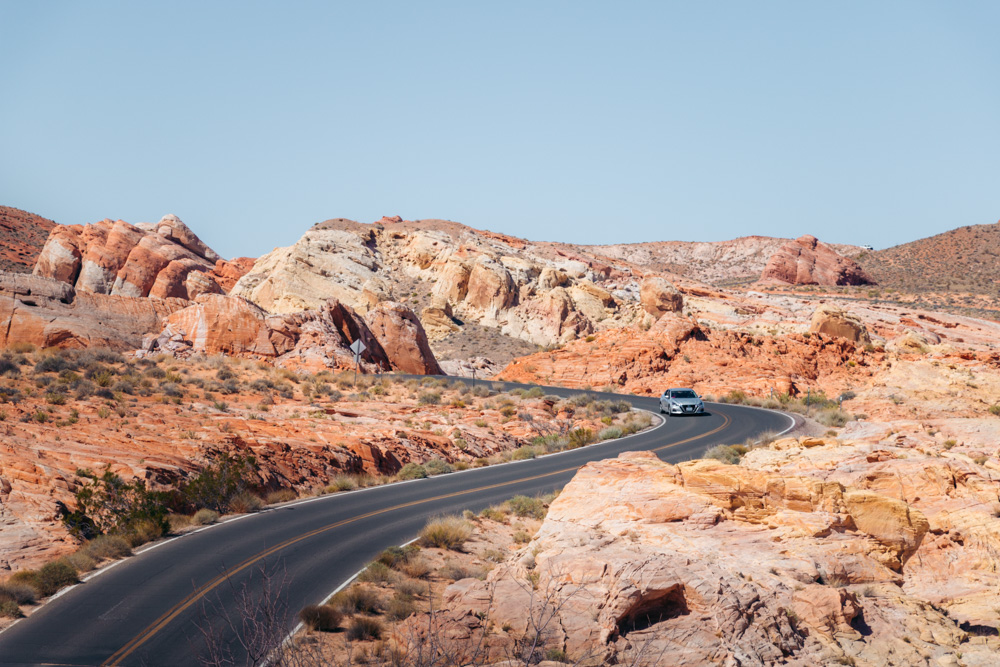
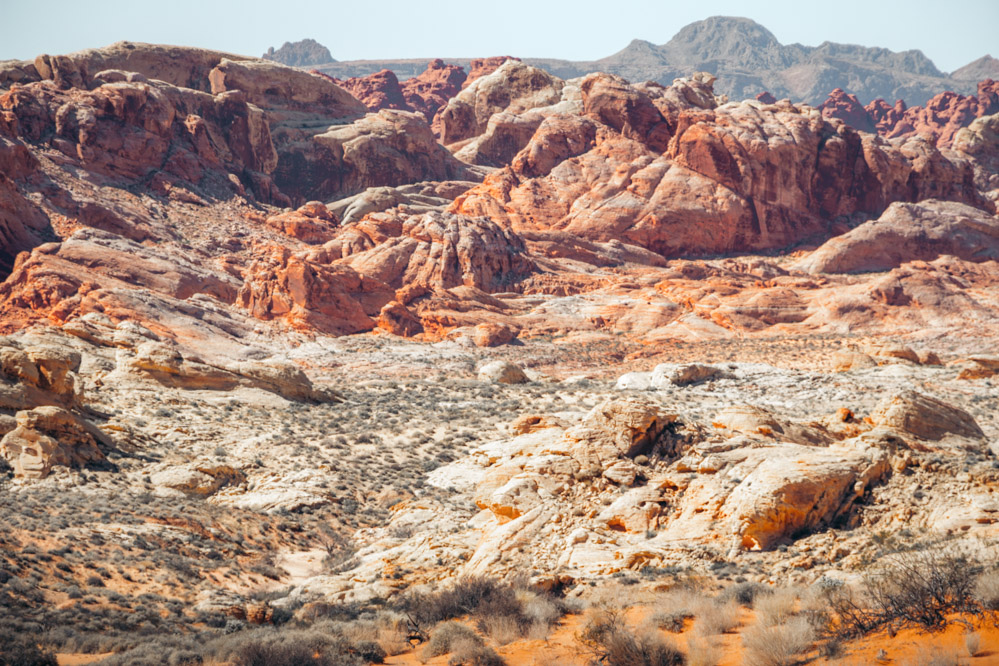
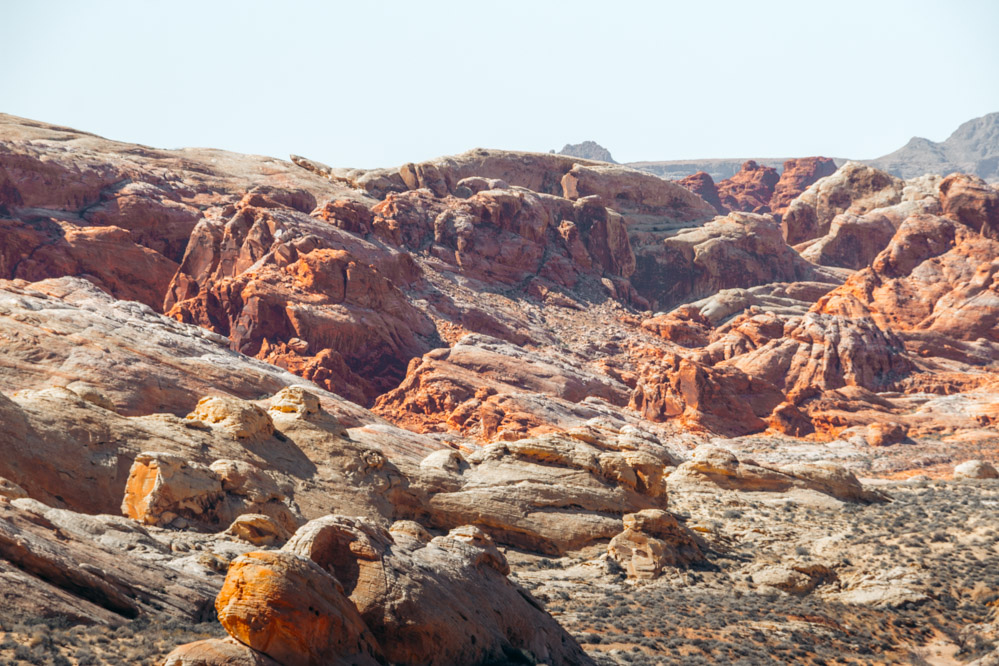
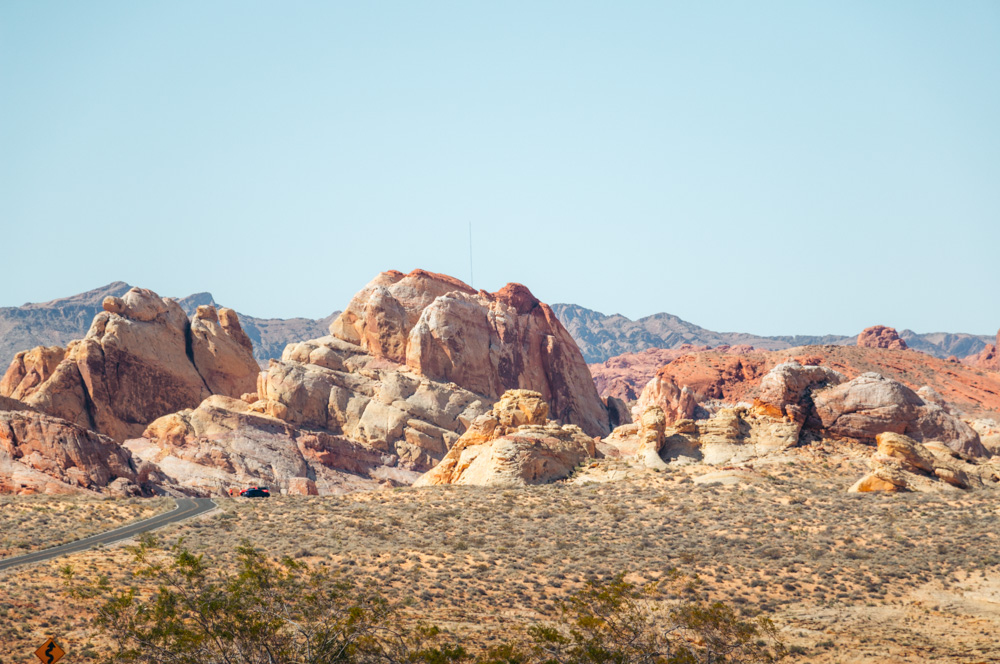
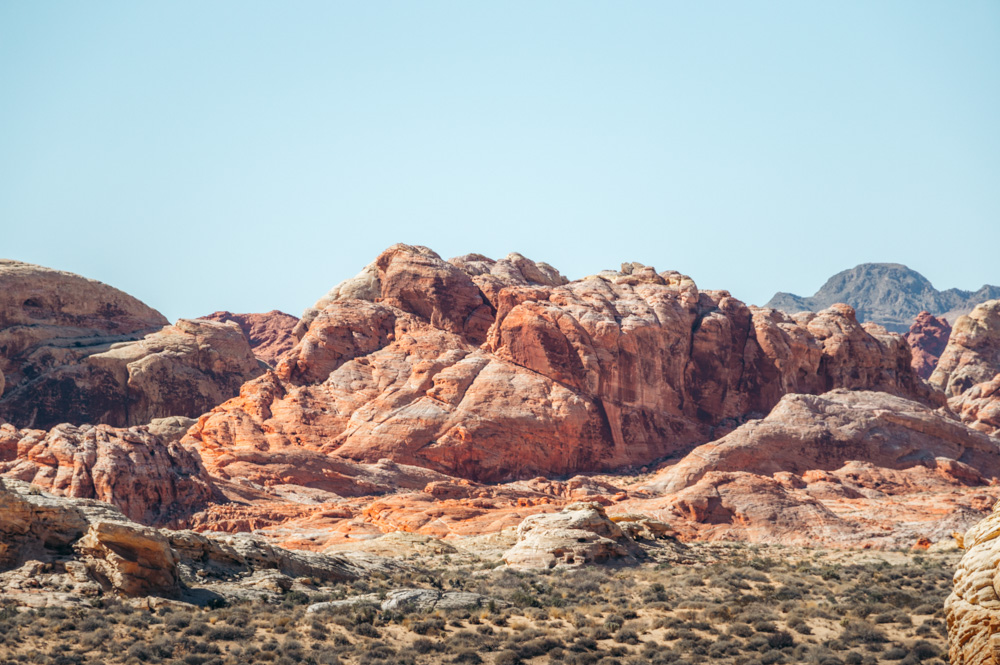
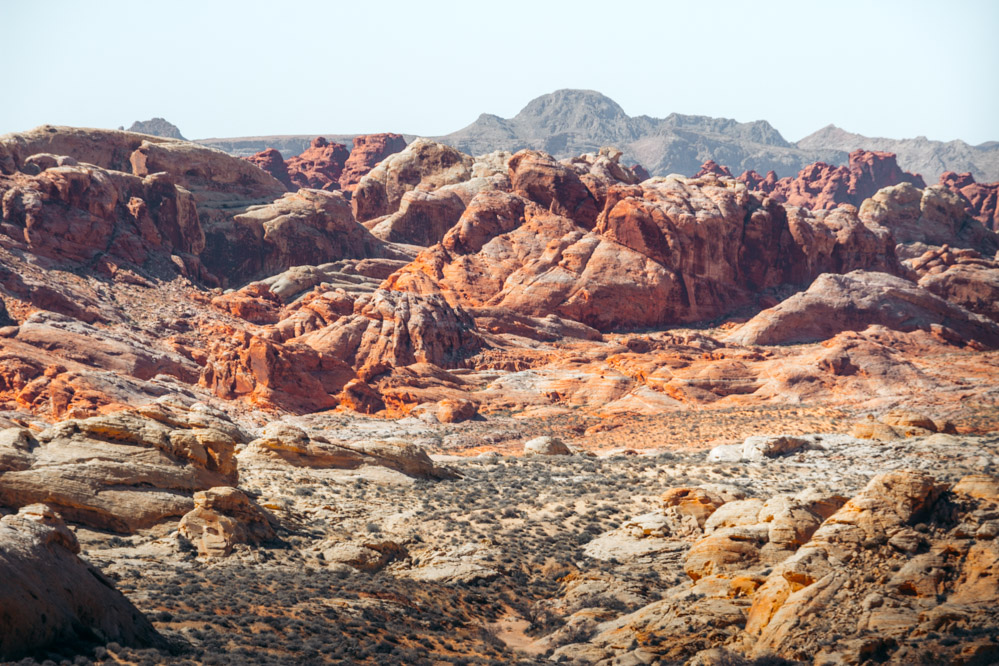
9. Rainbow Vista
As you continue driving along the main road, a place full of colorful sandstone formations, another epic landmark you ought to visit in the Valley of Fire, comes into view. Welcome to Rainbow Vista where the multicolored rocks stretch as far as the eye can see! With such outstanding natural beauty around, the place is often used for wedding photoshoots.
TIP: Similarly, make use of a small parking lot (although it gets packed fast), restrooms, and a picnic area nearby if you need a break.
10. Fire Canyon/Silica Dome
Take a short detour and visit a different area of Valley of Fire State Park. After you pass the Rainbow Vista area, turn right and merge onto Fire Canyon Road. Your effort will be greatly rewarded in just a few minutes when marvelous views of the red sandstone appear on the horizon.
TIP: Have enough of the panoramic vistas and want to stretch your legs? Explore the numerous canyons and rock formations, including the famous Silica Dome. This pastel formation is one of the greatest examples of a deposit made out of almost pure silica.
11. Fire Wave
The multicolored Fire Wave is one of the most popular day hikes in Valley of Fire State Park and for a reason. Raging from red, yellow, pink, beige, and white, and adorned with swirling stripes, this Nevada’s bucket list destination is out of this world. A distinct shape of a wave adds special allure to the vibrant sandstone formation. Make sure to add this short hike to your day adventures in Valley of Fire State Park and let your senses explode.
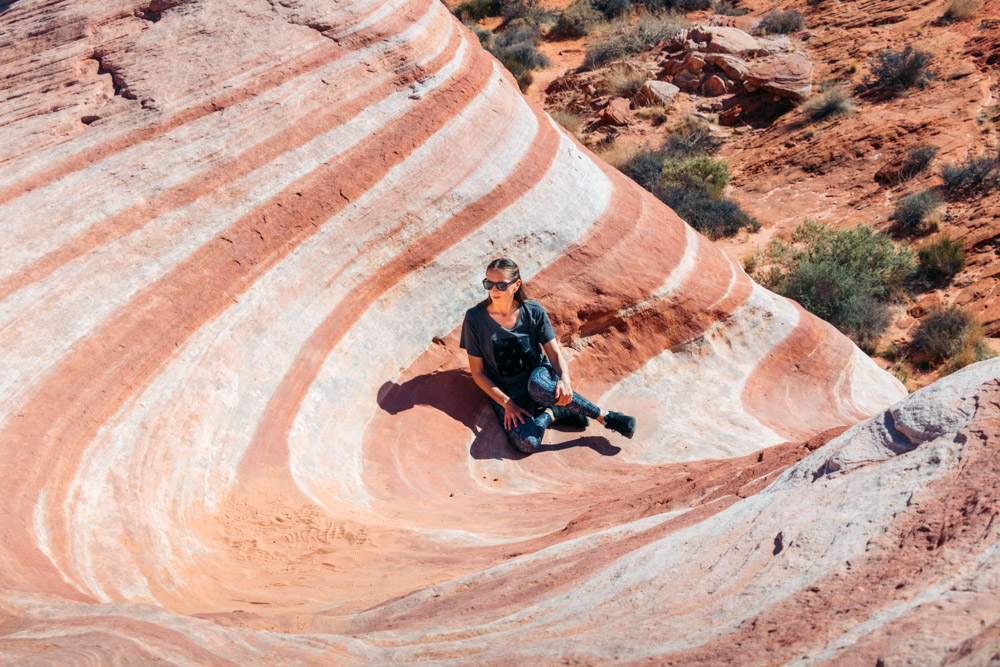
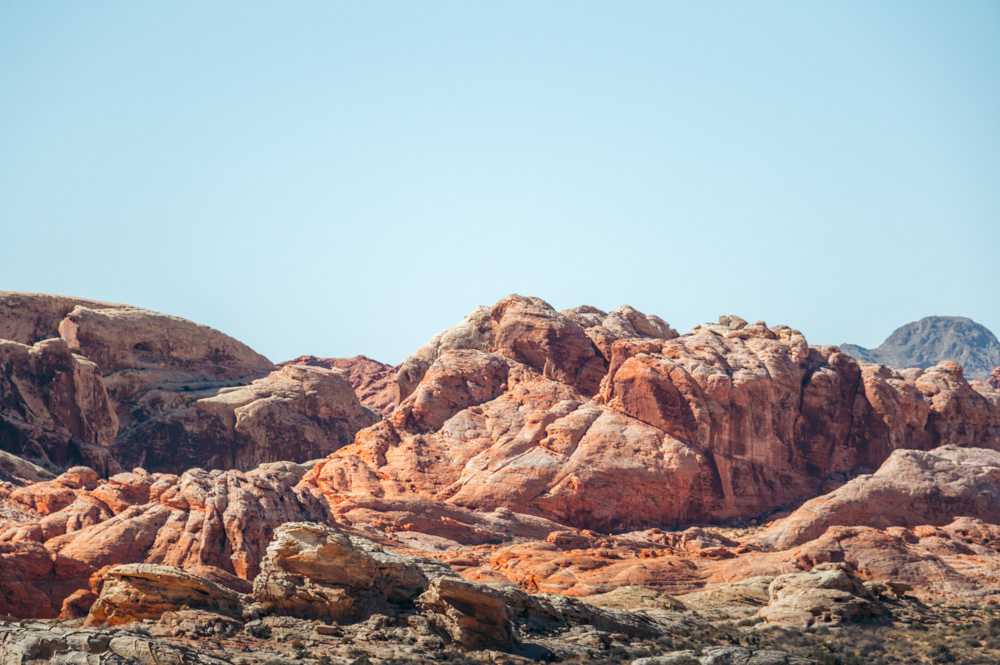
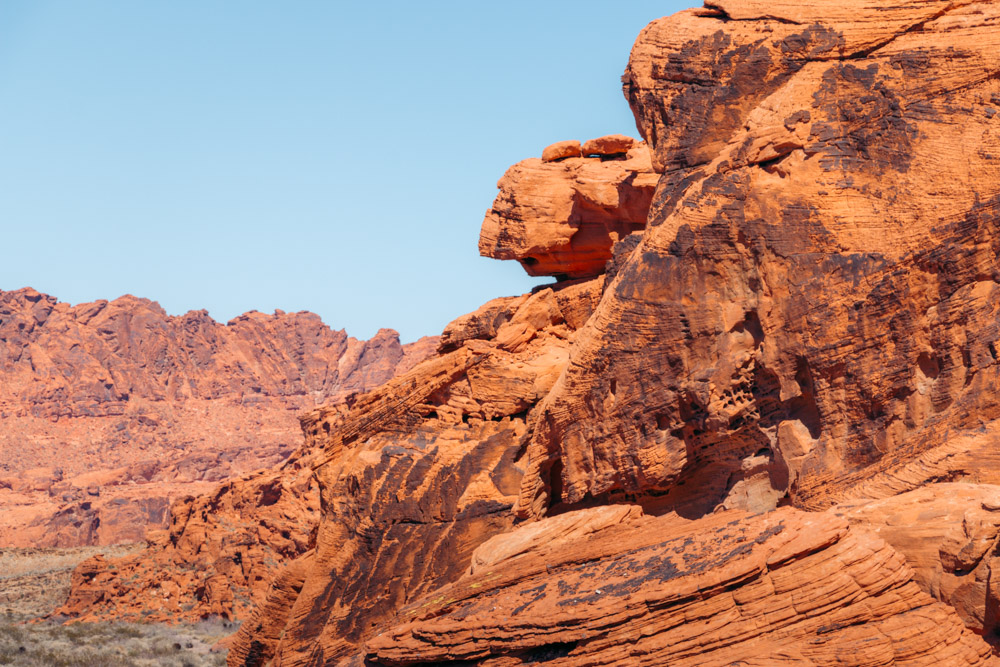
12. White Domes
The final destination to visit at the far end of Valley of Fire State Park is the multicolored, multi-terrain White Domes. Home to the longest slot canyon in the park, iconic white sandstone formations, and panoramic desert vistas, the place is to be thanked for the construction of the park’s road.
History. The necessity for more convenient travel through the park arose with the shooting of the movie “The Professionals” in 1966. Over time, day visitors would drive deeper in the Valley of Fire to see the iconic White Domes in person.
TIP: The White Domes day use area sits at the end of White Domes Road. On top of the astounding surroundings and an easy loop trail, it offers a parking lot, restrooms, and a picnic area. The bigger parking space also serves as the starting point of many day hikes, including the Fire Wave excursion.
13. White Domes Road
Although White Domes Road is not a completely new attraction at this point, the area deserves a separate mention. The scenic drive with ample roadside stops and a few parking lots to take in the views tops the list of Nevada’s spectacular routes. Spanning 5.5 miles, it enhances your day visit to the Valley of Fire with the most dramatic vistas and hikes.
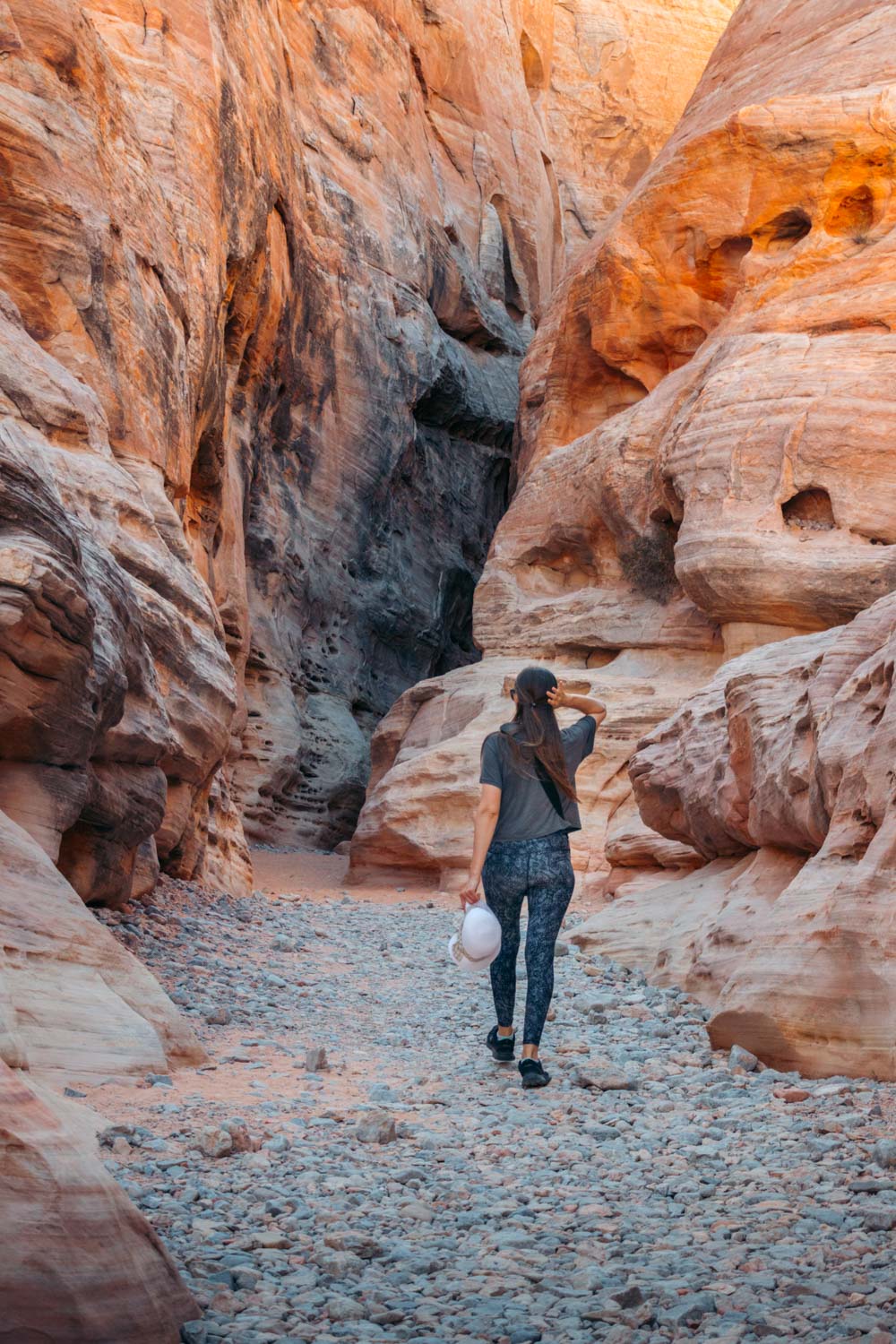
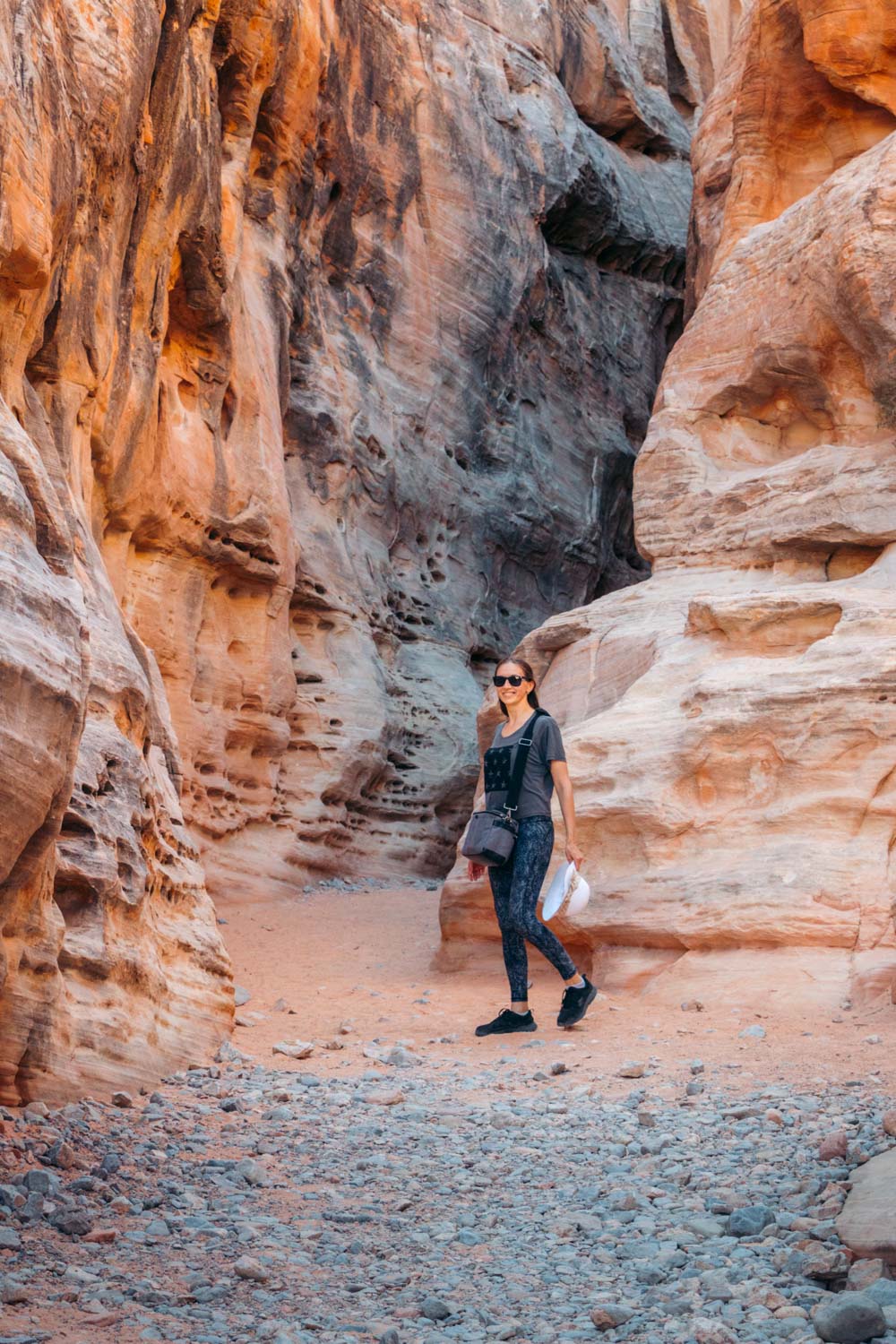
14. Seven Sisters
It’s time to head back down White Domes Road and drive toward the East Entrance. The first place you must visit once back on Valley of Fire Highway is Seven Sisters. A solitary group of seven tall, red boulders looks rather odd surrounded by the sandy desert and no other rocks around.
History. The now lonely Seven Sisters once were part of a red sandstone formation. Merciless erosion, however, stripped away the surrounding deposits, separating the rocks and sparing only several sections of the original solid structure.
It’s predicted that the rock towers won’t live here in complete solitude forever. Multiple “blow holes” on their surface give a valid reason to believe that in hundreds of years Seven Sisters will also face their destruction.
TIP: The site sits near the paved road. A small parking lot, a few picnic tables, and restrooms are nestled nearby. The place is never as busy as other areas of the Valley of Fire. This, along with the dramatic rocks in the background, helps elevate the site as one of the most unique wedding shoot locations in the state.
15. The Cabins
The historic Cabins are the next place to add to your day itinerary in Valley of Fire State Park. The landmark is located near Valley of Fire Highway, not far from the East Entrance. Not authentic to the area, the structures appeared in the park in the 1930s. The Civilian Conservation Corps built them to provide a temporary shelter for travelers of the Arrowhead Trail. Today, the Cabins serve as a picnic area.
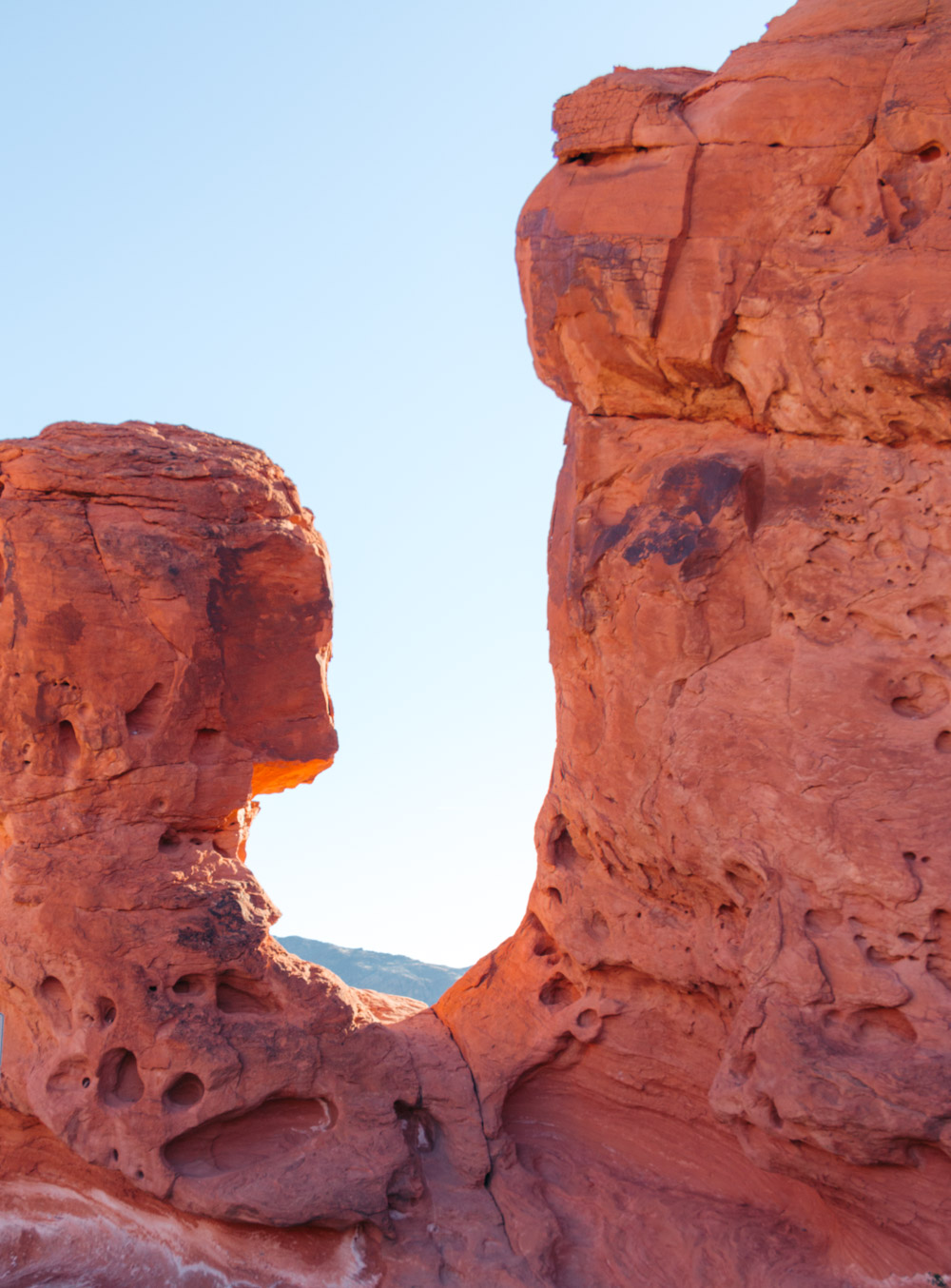
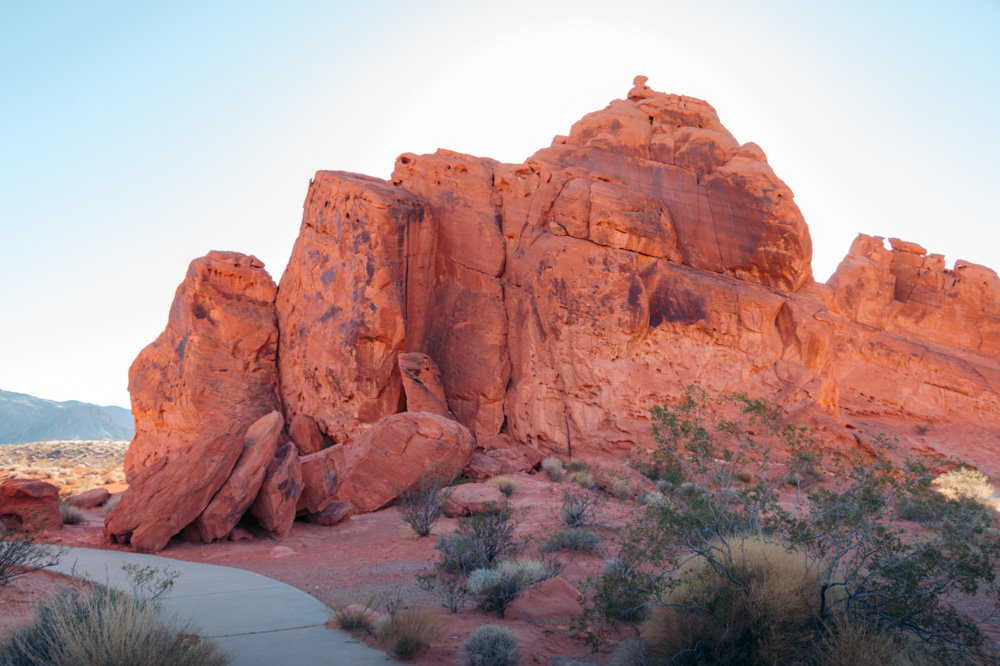
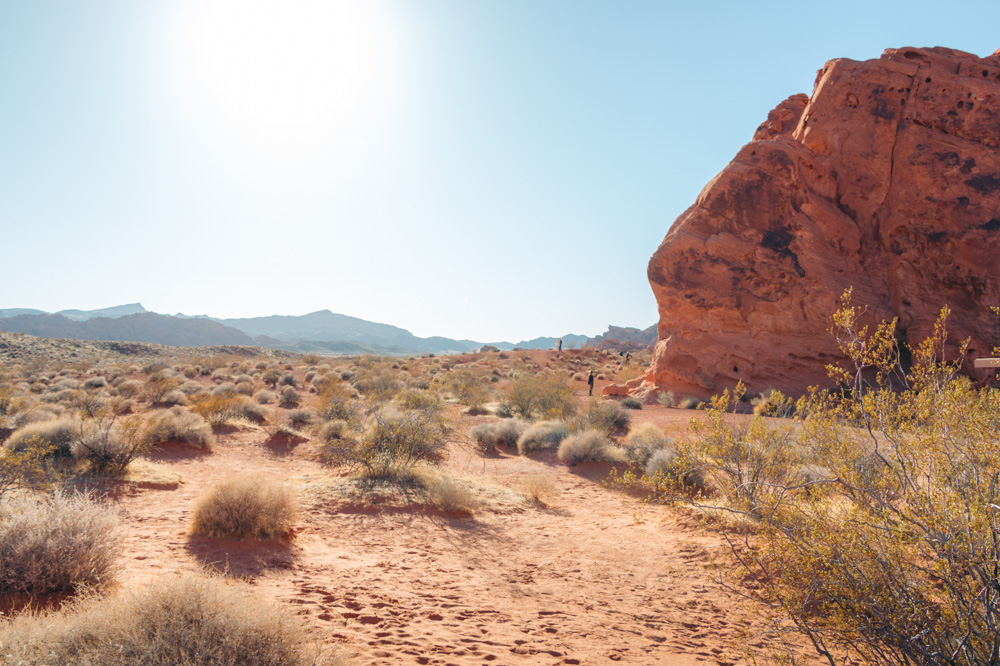
16. Clark Memorial
Don’t expect to find many examples of human intervention in the desert during your day visit to Valley of Fire State Park. The Clark Memorial, however, deserves at least a quick stop to remind you how strangely beautiful and dangerous the Valley of Fire can be.
History. John J. Clark was a sergeant of the New York Cavalry when he was honorably discharged. Once retired, the man emigrated to Southern California. One day traveling from Bakersfield to Salt Lake City on his buckboard, he stopped in the Valley of Fire. Some historians insist that Clark was looking for water, but never succeeded at finding it. Eventually, he crawled under his buckboard and died, presumably from thirst. His body was found a few days later, on June 30, 1915.
17. Elephant Rock
The last destination to visit in Valley of Fire State Park (the very first one for those who access the park from the East Entrance) is photogenic Elephant Rock. The deposits of sand not only created a large mountain-like formation here, but formed it into a distinct shape of an elephant.
TIP: The structure is visible from the road. Side-road parking on Valley of Fire Highway, however, is limited. Therefore, you’re better off parking in a parking lot near the entrance and walking to the rock formation.
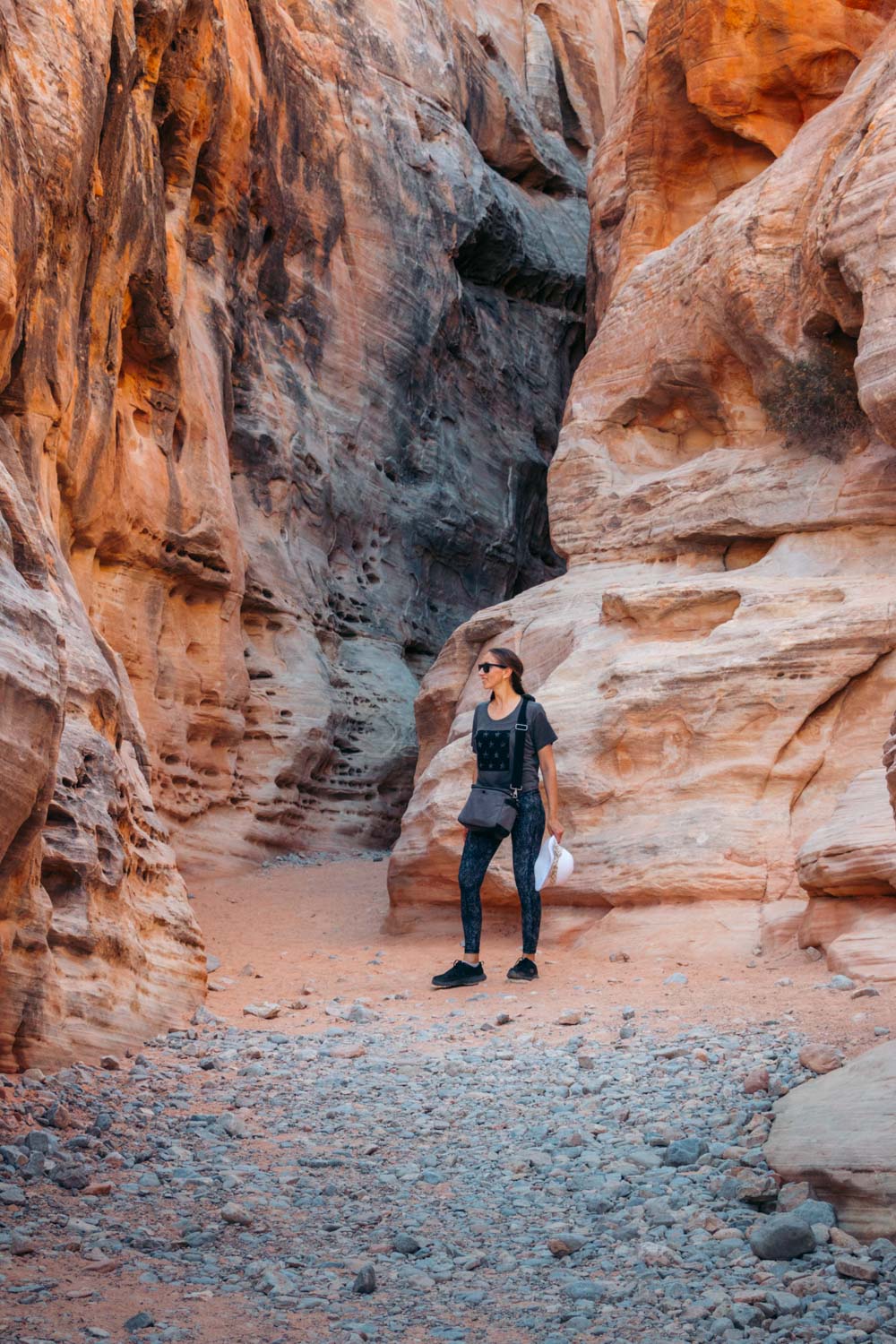
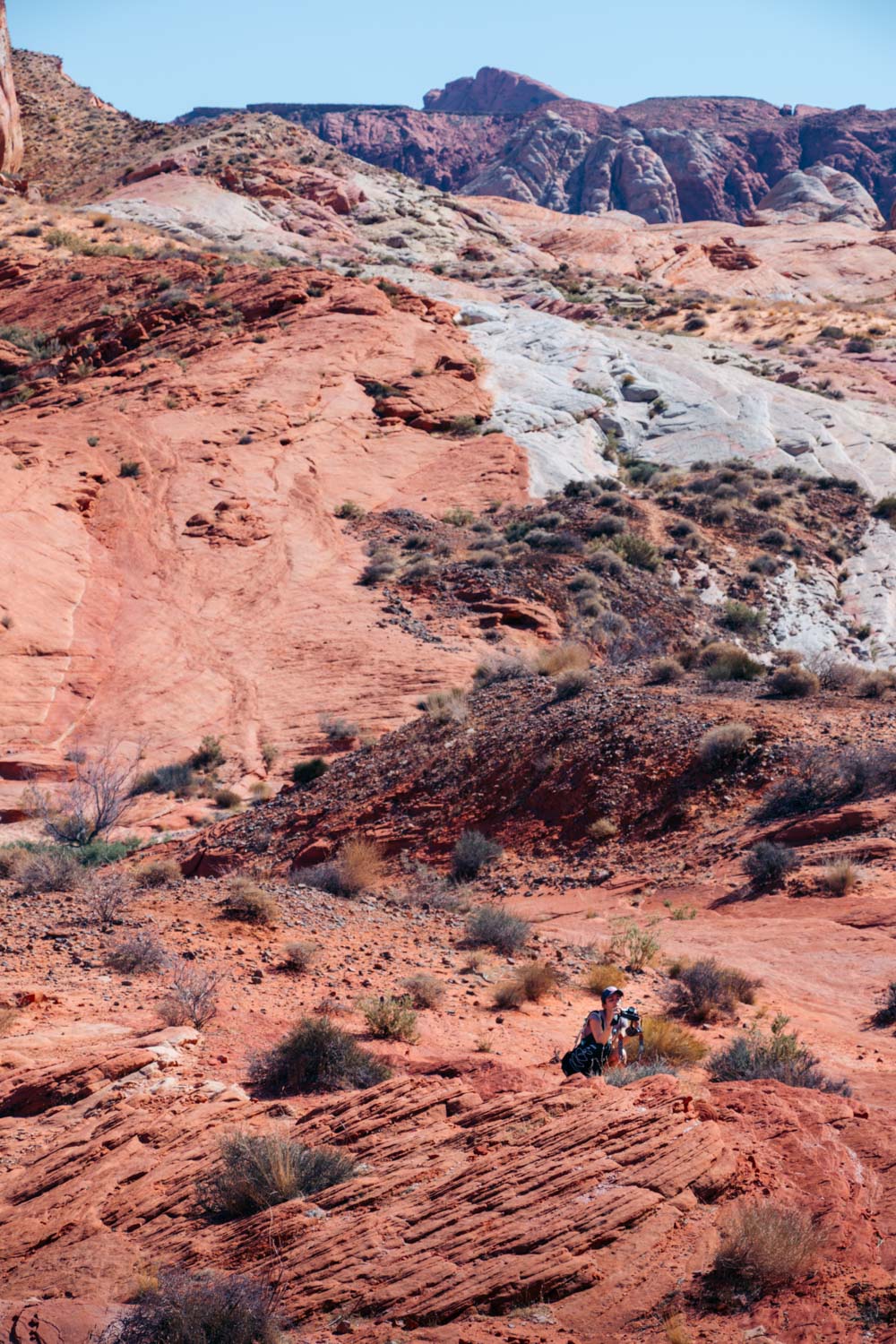
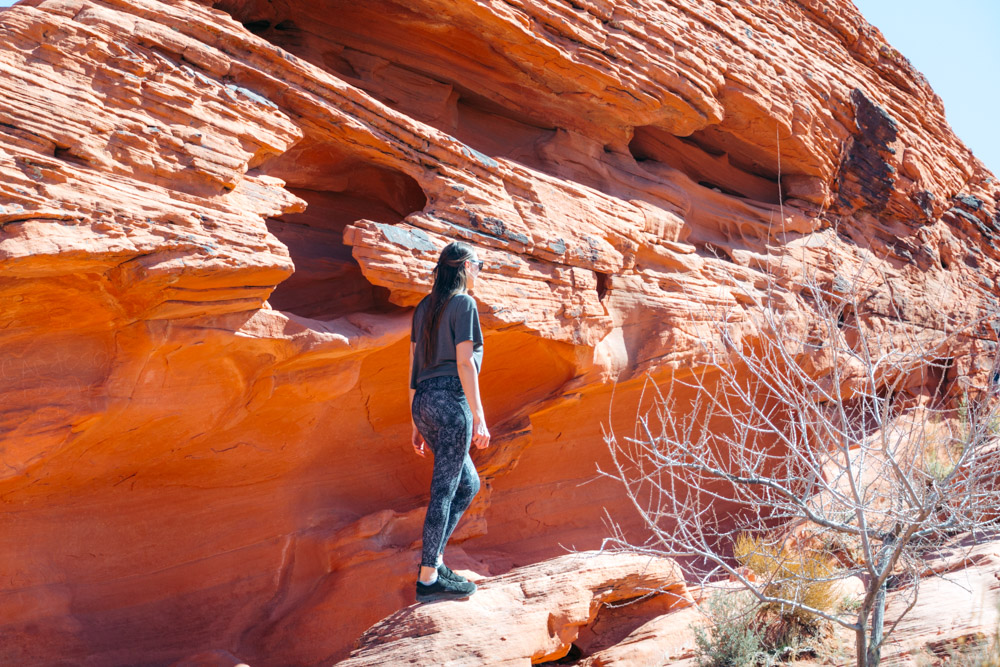
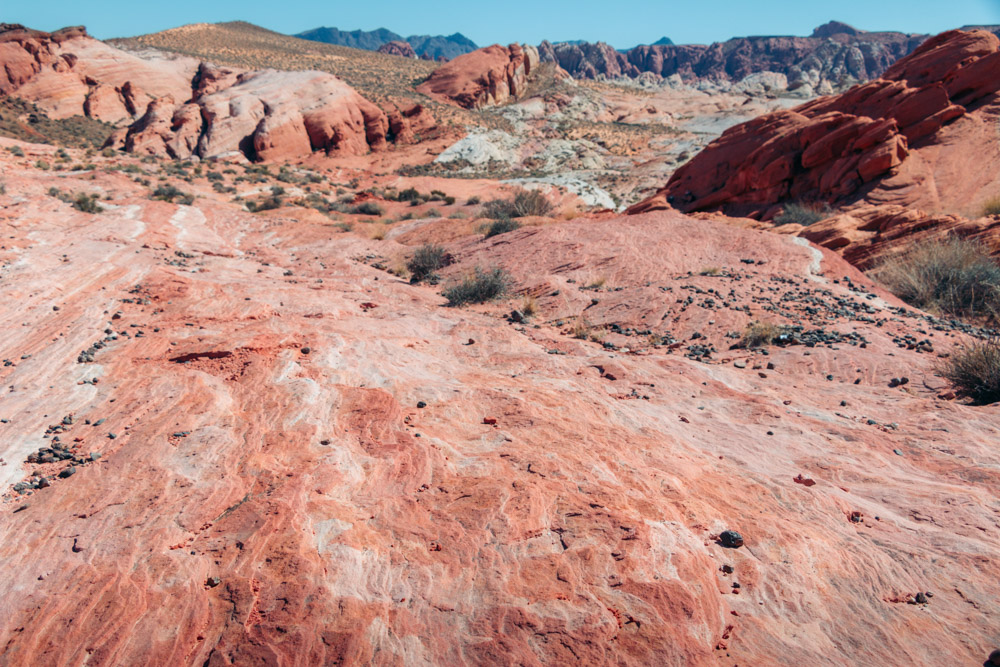
The Best Hikes in Valley of Fire State Park
Hikers have the best time of their lives in Valley of Fire State Park. The area entices with some of the best trails in the stare. Whether you plan to spend a day or a few hours in the Valley of Fire, make sure to check out some of these hikes.
Fire Wave Trail
The 1.5-mile round-trip Fire Wave Trail surprises with a lot of natural shade and the largest sandstone formations festooned with red swirling stripes. The trailhead sits right across the road from the parking lot #3.
White Domes Loop Trail
The White Domes Loop Trail runs for 1.25 miles, squeezing through a slot canyon and rolling up free across the open desert area. The scenic hike suits both beginners and advanced hikers.
Mouse’s Tank Trail
The Mouse’s Tank Trail is quite short. It spans approximately 0.4 miles one way. The place draws first of all history buffs interested in ancient petroglyphs.
Rainbow Vista Trail
A sea of colors unfolds along the 1-mile Rainbow Vista Trail. Even if you don’t prioritize hiking during your day trip to the Valley of Fire, stop at a parking area and enjoy the natural “painting” from here.
Pastel (Pink) Canyon Trail
The 2-mile round-trip trail (can be shorter or longer depending on how far you want to hike) haven’t made it onto the official map of the park yet. Frequent day visitors of the Valley of Fire, however, claim that it’s one of the most scenic areas in the region.
TIP: The trailhead is located near Wash #5. Alternatively, you can park in the parking lot #3, visit the Fire Wave, and walk down to the wash and eventually the Pastel Canyon Trail.
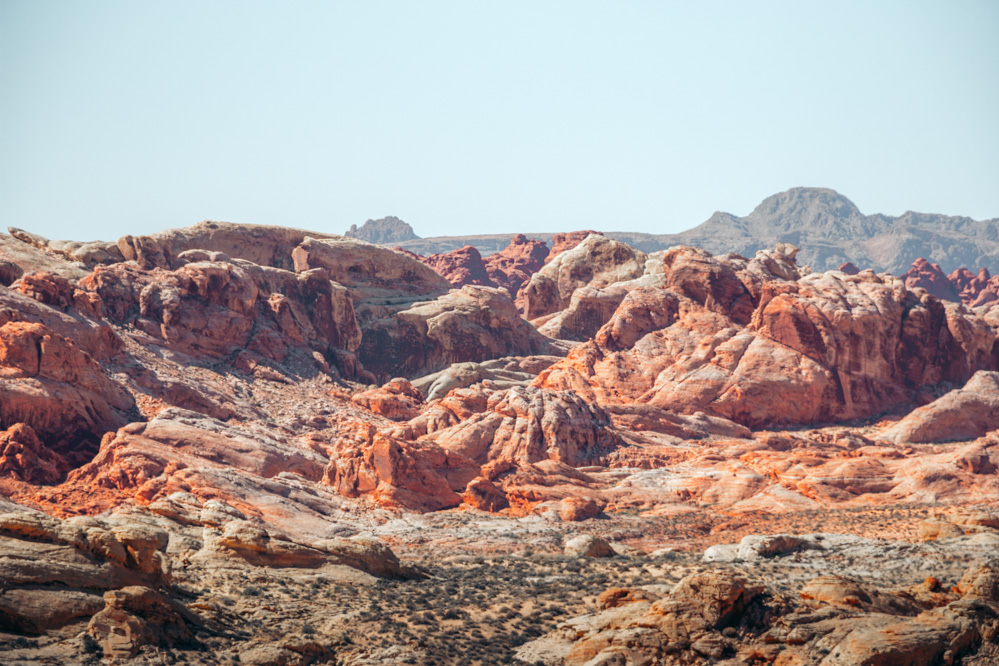
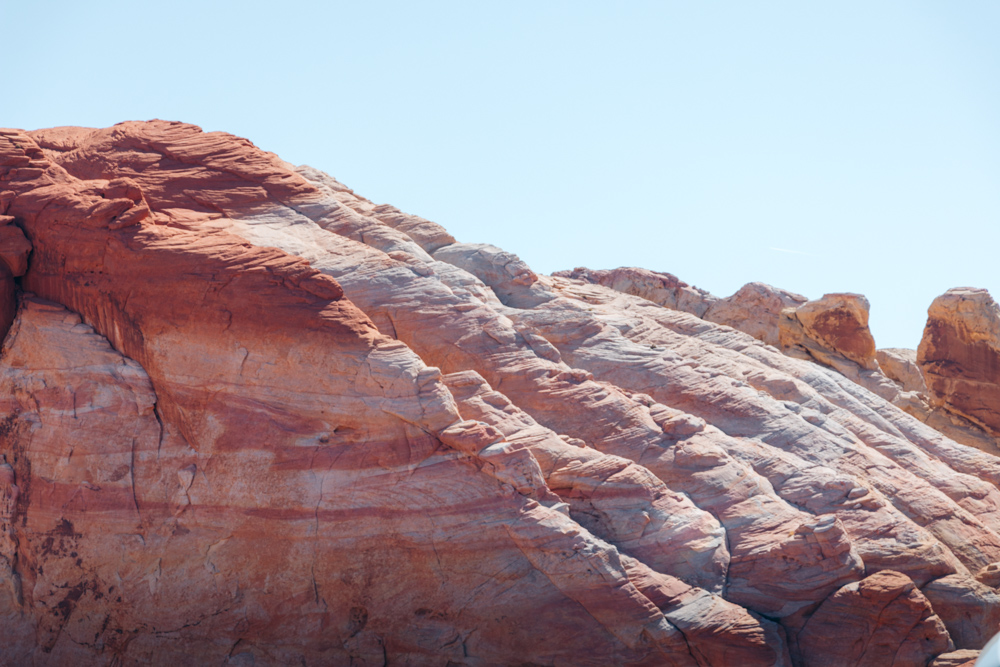
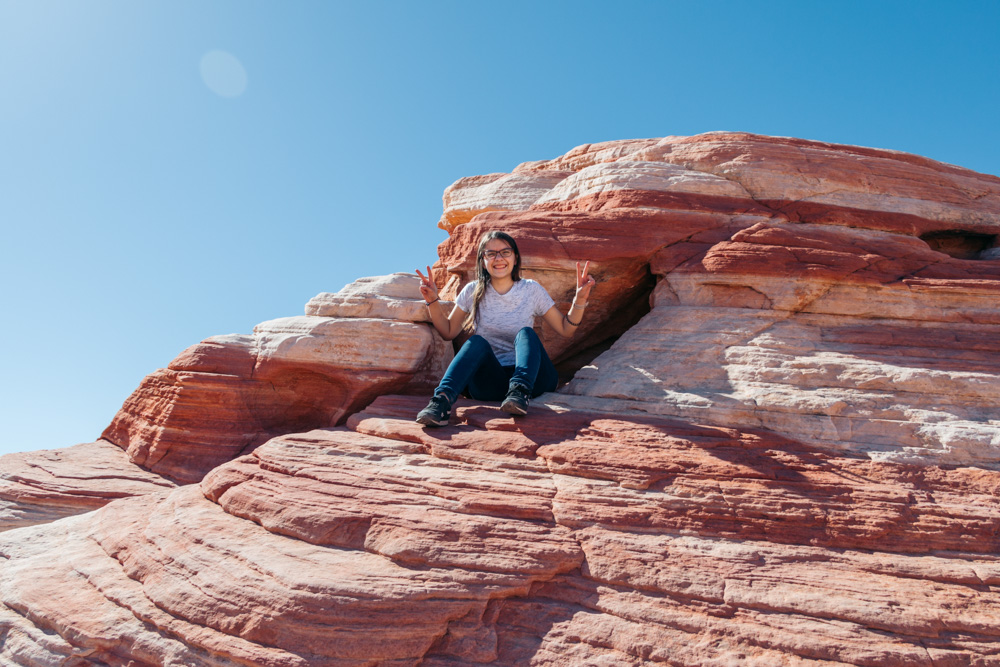
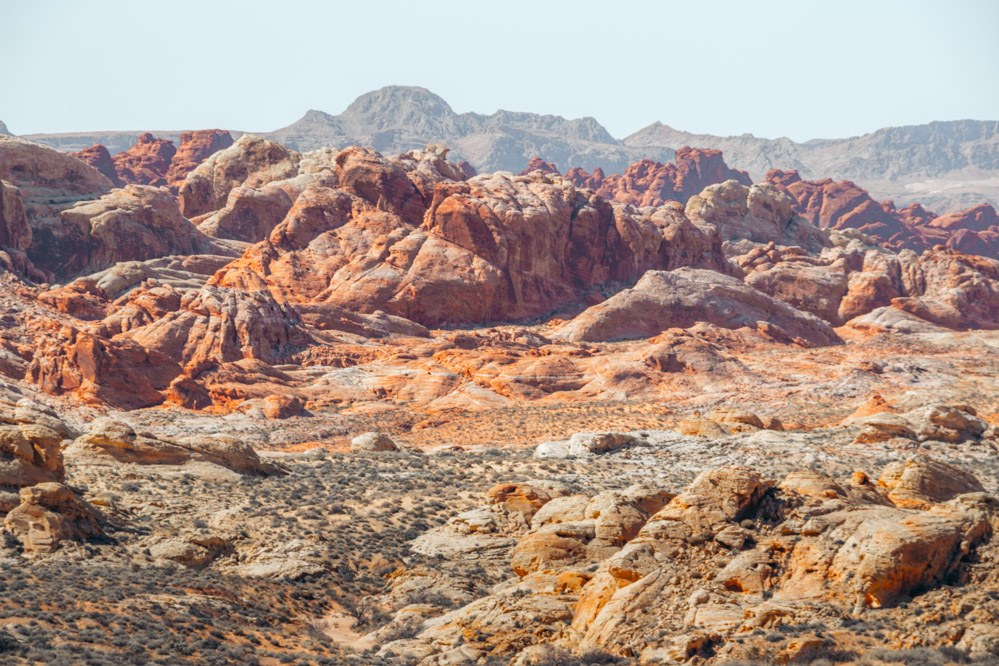
The Most Photographed Places to Visit in Valley of Fire State Park
- Elephant Rock. The sandstone elephant gathers crowds of photographers that visit the Valley of Fire just to capture its unique beauty.
- Arch Rock. The remarkable shape of Arch Rock and easy accessibility make it one of the most epic and convenient natural landmarks to photograph in the Valley of Fire.
- Fire Wave. Many visit Valley of Fire State Park just to capture the mesmerizing swirling stripes and splendid shapes along the Fire Wave Trail. The natural attraction is indisputably one of the most photographed places in the area.
- Fire Cave/Winstone Arch. Located inside a wave tunnel in the sandstone, the isolated cave is not an easy area to photograph. Apart from its secluded location, the place is so tiny that you need to get creative and try different angles to capture its uniqueness.
- Rainbow Vista. The vibrant colors and remarkable shapes are the main reasons to go on a day trip to the Valley of Fire. The natural hues look even more profound at the Rainbow Vista area. You can spend the entire day photographing these shades and shapes and still wanting to come back for more.
- Slot Canyon of the White Domes. The excellent desert views, the red and yellow terrain, the towering walls of the slot canyon… Do you need any other reasons to spend a day in the Valley of Fire with a camera in your hands, photographing the natural abundance of the White Domes.
Visit Valley of Fires State Park: Map
Where to Stay in and near Valley of Fire State Park
1. Camping
If desert inhabitants that roam in Valley of Fire State Park in search of food at dusk don’t scare you, consider extending your visit and spending a night here. The area offers 2 campgrounds with a total of 72 units. While some of the campsites are primitive, others provide shaded tables, grills, water, and hookups for RV’s. To make your visit to the Valley of Fire even more enjoyable, opt for the sites with dump stations and showers.
No prior reservation is needed. All campsites work on a first-come, first-served basis. The campgrounds limit a number of days one can stay in the park, 14 nights in a 30-day period.
Apart from the regular campsites, the area offers 3 group sites. Each of them accommodates up to 45 people. Prior reservation for these is required.
2. Places to Stay near Valley of Fire State Park
Let’s be honest, camping is not for everybody. Those who’d rather stay away from the dark sky dotted with bright stars and distant howls of coyotes can stay overnight in the nearest cities.
Moapa Valley
Moapa Valley is the closest place to look for accommodation near Valley of Fire State Park.
- North Shore Inn at Lake Mead. Affordable rooms, a seasonal pool, free WiFi and parking, and most importantly the great location for Valley of Fire State Park are guaranteed at the North Shore Inn.
Las Vegas
Las Vegas sits approximately one hour away and works perfectly for a one- or multi-day visit to Valley of Fire State Park.
- Bally’s Las Vegas Hotel & Casino ($). Located on the Las Vegas Strip, Bally’s Las Vegas Hotel & Casino surprises with affordable prices, clean and cozy rooms, a swimming pool, and a restaurant.
- Mandalay Bay ($$$). For a luxurious stay, head over to Mandalay Bay. After an impactful visit to the Valley of Fire, the hotel’s outdoor splash swimming pools complete with a real sand beach give a much-needed rest. Those who long for more epic views can stay inside their rooms and admire the Gambling Capital of the World from the floor-to-ceiling windows.
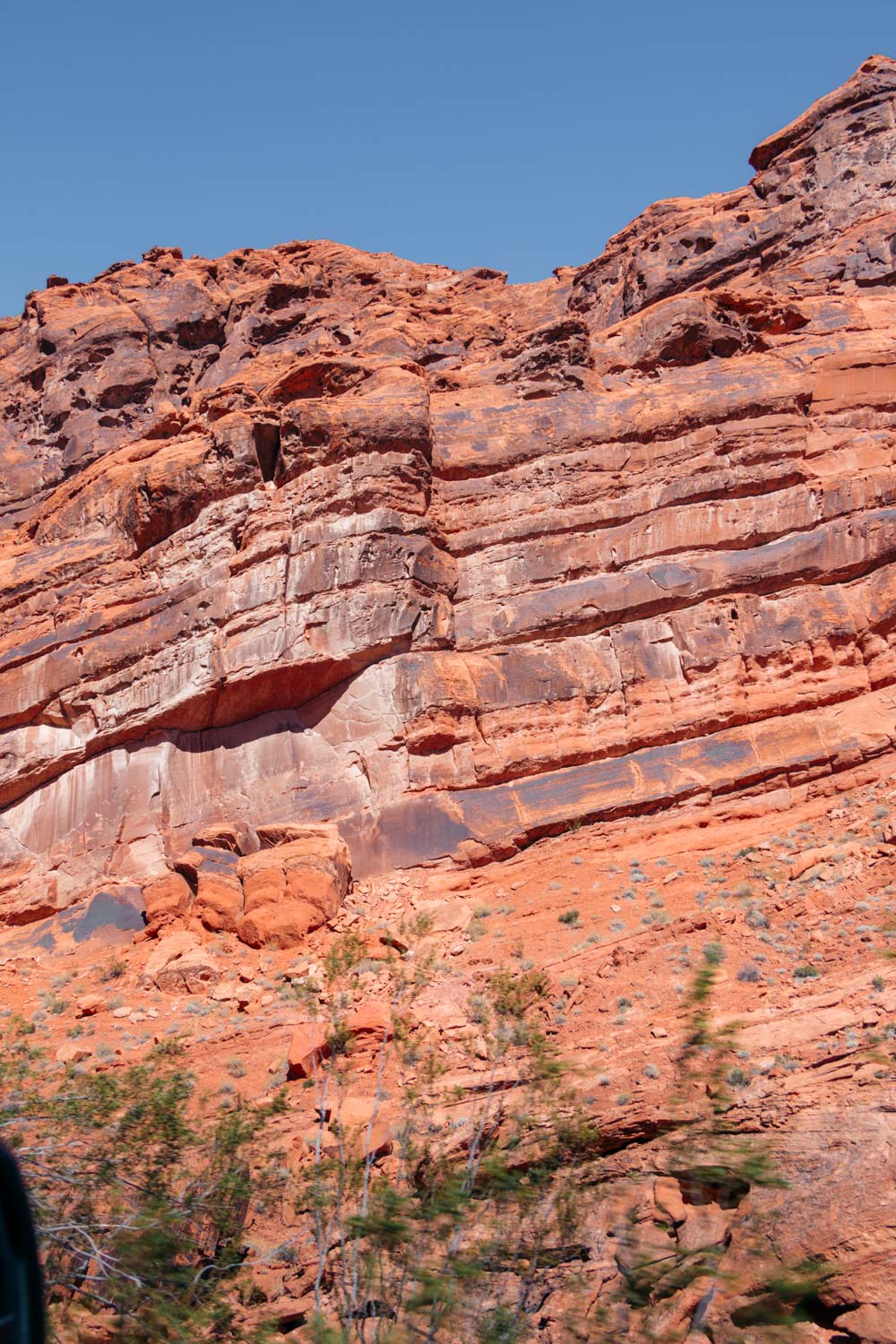
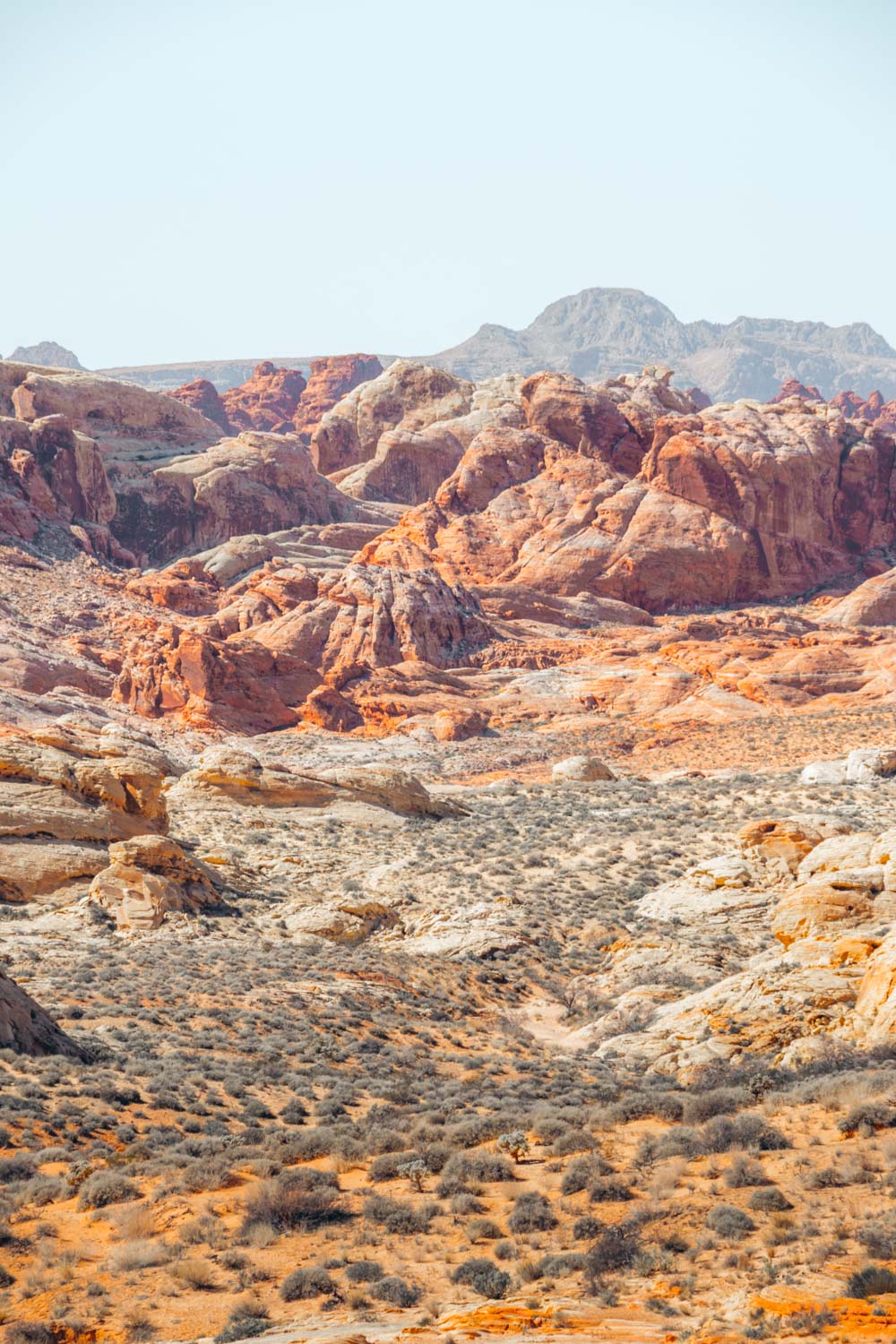
Visit Valley of Fire: Admission and Permits
Visit Valley of Fire State Park any time of the year, from dawn to dusk. The state park charges $10 per vehicle for day use. Travelers from outside of the state who plan to add a visit to Valley of Fire State Park to their Nevada’s trip must pay $15 per vehicle per day.
Nevada’s campers pay $20 per vehicle per night, the day-use fee included. The non-Nevada travelers that long to extend their visit to the Valley of Fire and spend a night in the wilderness pay $25 per vehicle per night. The park charges extra $10 for sites with the utility hookups.
Planning to visit Valley of Fire State Park by bike? Your entrance fee costs $2 per bike.
The majority of hiking trails in the park don’t require a hiking permit.
Know before You Go: You must pay the fees at the entrance stations upon arrival. As an America the Beautiful pass holder, I wondered if I could visit Valley of Fire State Park using the national parks’ pass. The answer is no. You must pay the fees that the State of Nevada charges for every day visit and camping in Valley of Fire State Park.
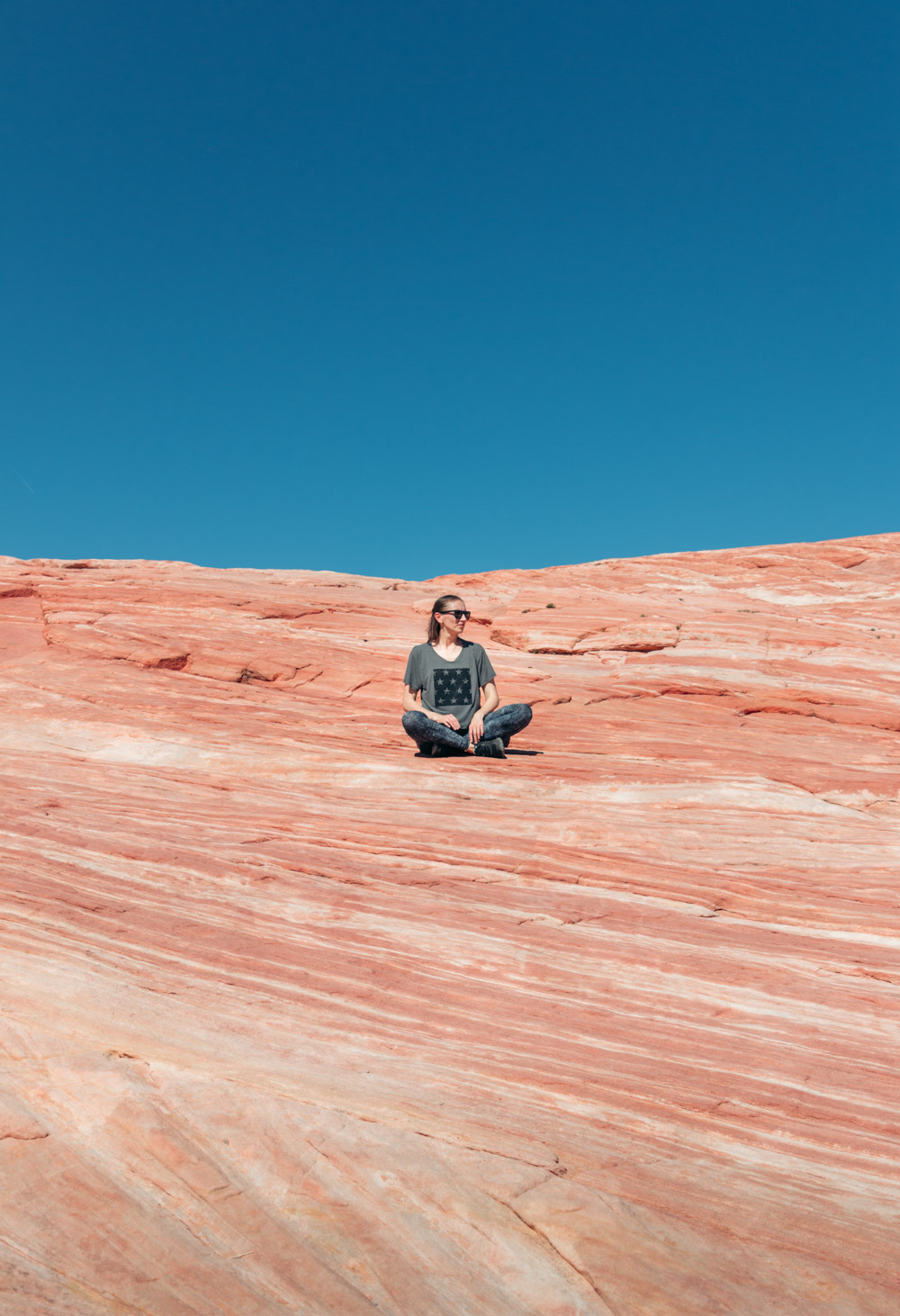
Visit Valley of Fire: Helpful Tips
Safety Tips to Follow During Your Visit to Valley of Fire
- Drink plenty of water when visiting Valley of Fire State Park. The place is nestled in the desert where temperatures can get too high. Drinking water to preserve your energy is crucial in this hostile environment.
- Plan the whole day visit to Valley of Fire State Park. The gorgeous landscape and the remarkable sandstone formations will indeed keep you for that long. Thus, be sure to bring along lunch and snacks. There are no places to grab a bite in the park.
- Sunscreen should be essential. Even a short visit to Valley of Fire State Park can take a toll on your skin. We’re talking about nasty sunburns here. So use sunscreen, and a lot of it.
- Raincoats might come in handy when you visit Valley of Fire State Park in July or August. The afternoon rains prevail at this time. Use waterproof layers unless you don’t mind feeling some desert moisture on your skin.
Valley of Fire State Park’s Regulations to Comply with During Your Visit
- Comply with Valley of Fire State Park’s hours and regulations during your visit. You must leave the park before it gets dark. Only campers with camping permits are allowed in the area at night.
- Feel free to visit Valley of Fire State Park with your pets. Dogs are allowed on the majority of the trails in the park. Keep them on leash, though.
- Respect wildlife. Stay away and certainly don’t feed bighorn sheep if you happen to spot them during your day visit to Valley of Fire State Park. Moreover, don’t harm smaller desert inhabitants, such as lizards, and keep an eye on snakes that abound in the desert.
- No hiking permits are needed. Hike freely in Valley of Fire State Park. Once again, no hiking permits are required for most of the favorite trails.
- Stay only on designated routes. Going off the designated areas is not allowed. Respect the park and protect its fragile structures.
- Fires are permitted only in designated fireplaces. For more information, stop at the Visitor Center prior to venturing deeper into the park.
- Protect historic artifacts and rock formations. Sadly, some visit Valley of Fire State Park, caring less about its unique natural and human history. It’s not uncommon to see absurd scribblings next to ancient carvings. It’s not acceptable. Violators may be punished.
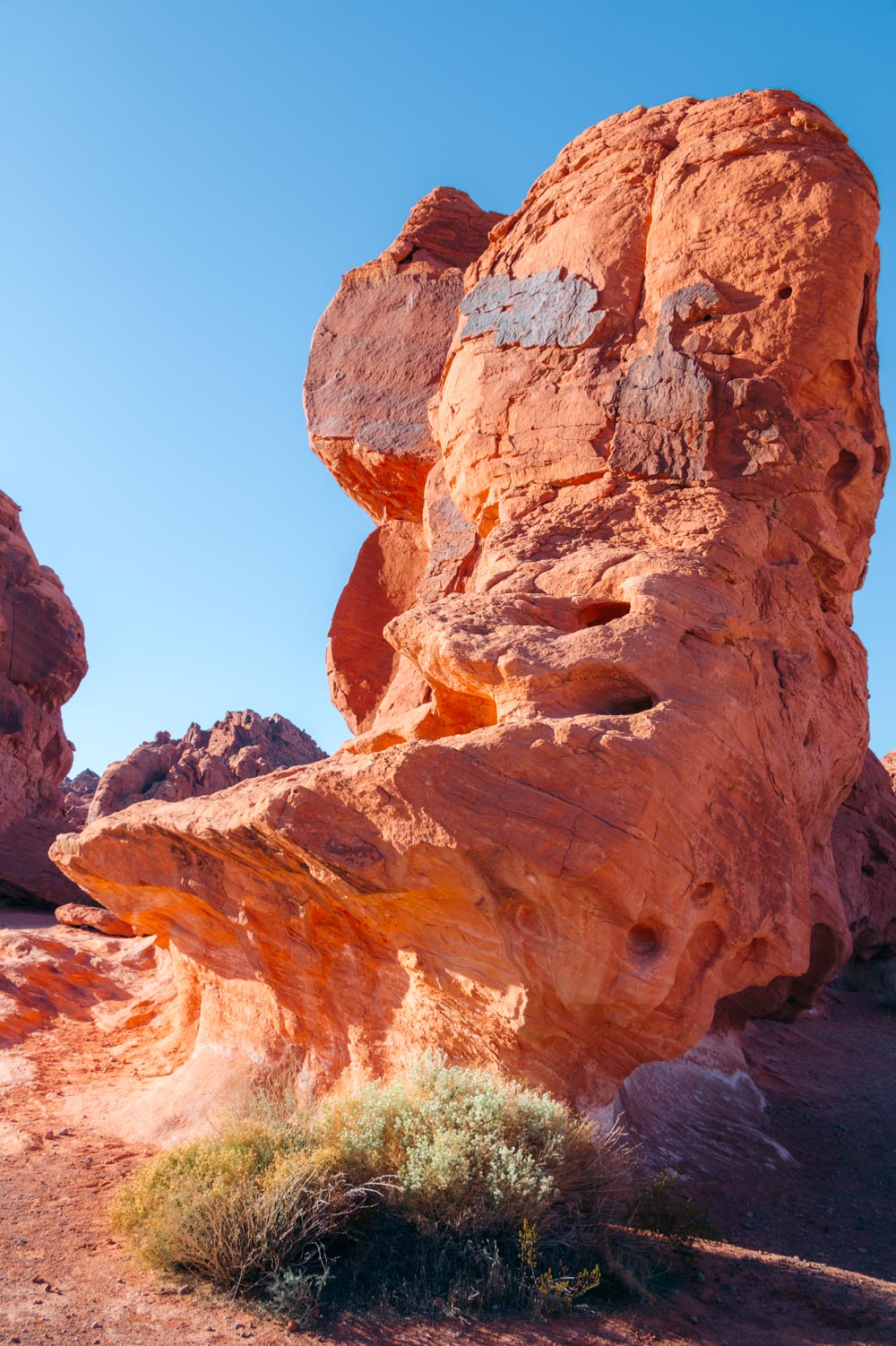
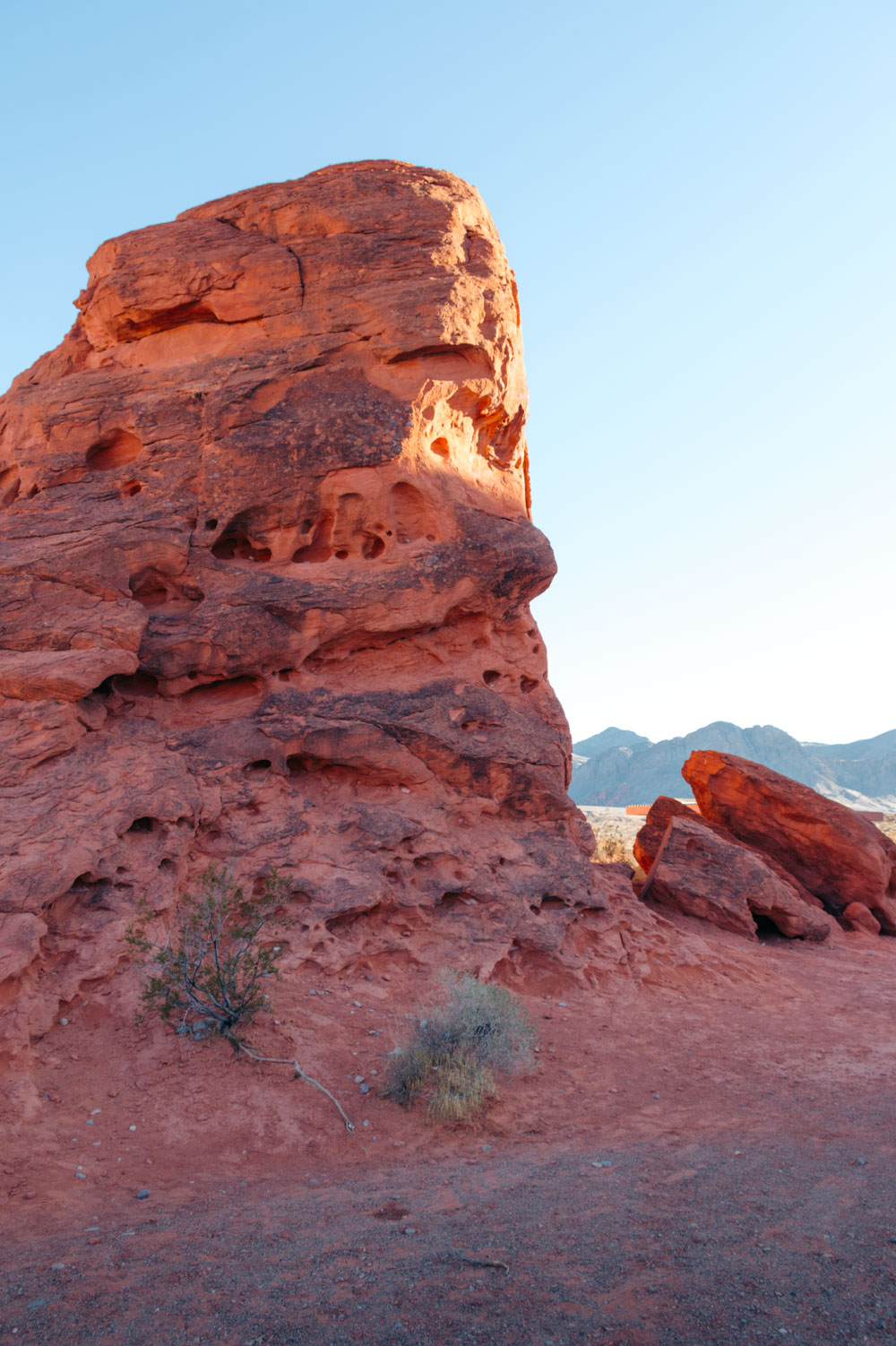
Frequently Asked Questions
Can you camp in Valley of Fire State Park?
Yes. Camping is allowed in Valley of Fire State Park. In fact, the area has 2 campgrounds with basic and more equipped campsites. On top of that, 3 group sites accommodate the parties of up to 45 people. Camping fees are paid upon arrival with the exception of the group sites that must be reserved in advance.
Can you use drones in Valley of Fire State Park?
No. You can’t use a drone in Valley of Fire State Park. The majority of national and state parks are drone-free zones. Violators, if caught, must pay fines imposed by the state or federation.
Can you climb rocks in the Valley of Fire?
Yes and no. Rock climbing is permitted in designated areas only. You must restrain from climbing atop the most fragile sandstone formations such as Rock Arch.
Can you use the America the Beautiful pass to enter the Valley of Fire?
No. The America the Beautiful pass ensures access to all national parks and the majority of national monuments. The Valley of Fire is a state park that doesn’t accept any annual national passes.
What animals can you see in Valley of Fire State Park?
You hardly see any wildlife in the area. If you’re lucky, you can spot a bighorn sheep during a day visit to Valley of Fire State Park. The animals roam freely throughout the park, but stay away from the visitors. Lizards soak up the desert sun and seem not to mind the intruders if left undisturbed. Both venomous and non-venomous snakes thrive in Valley of Fire State Park. At night, coyotes, bobcats, kit foxes and jackrabbits get out of their hideouts in search of food.
